Human Resource Management Report: Tesco's Strategic HRM Practices
VerifiedAdded on 2022/12/26
|18
|5298
|57
Report
AI Summary
This report provides a comprehensive analysis of Human Resource Management (HRM) practices within Tesco PLC. It begins with an introduction to HRM, emphasizing its role in managing employees to improve organizational services and increase demand and profit. The report then delves into the main body, exploring the purpose and functions of HRM in workforce planning and resourcing, discussing the strengths and weaknesses of various recruitment and selection approaches, and examining the benefits of different HRM practices for both employers and employees. Further, the report evaluates the effectiveness of HRM practices in terms of organizational profit and productivity, analyzes the importance of employee relations in influencing HRM decision-making, and identifies the key elements of employment legislation and its impact on HRM. The application of HRM practices is illustrated with specific examples. The report concludes by summarizing the key findings and implications of HRM within the context of Tesco PLC. The report covers internal and external recruitment, selection processes, onboarding and training, employee engagement, and career development. It emphasizes the importance of functions such as hiring, performance management, learning and development, succession planning, benefits and compensation, HR information systems, and HR data analytics in driving organizational success. The report underscores the role of HRM in fostering a healthy working environment, promoting innovation, and ensuring long-term business survival.
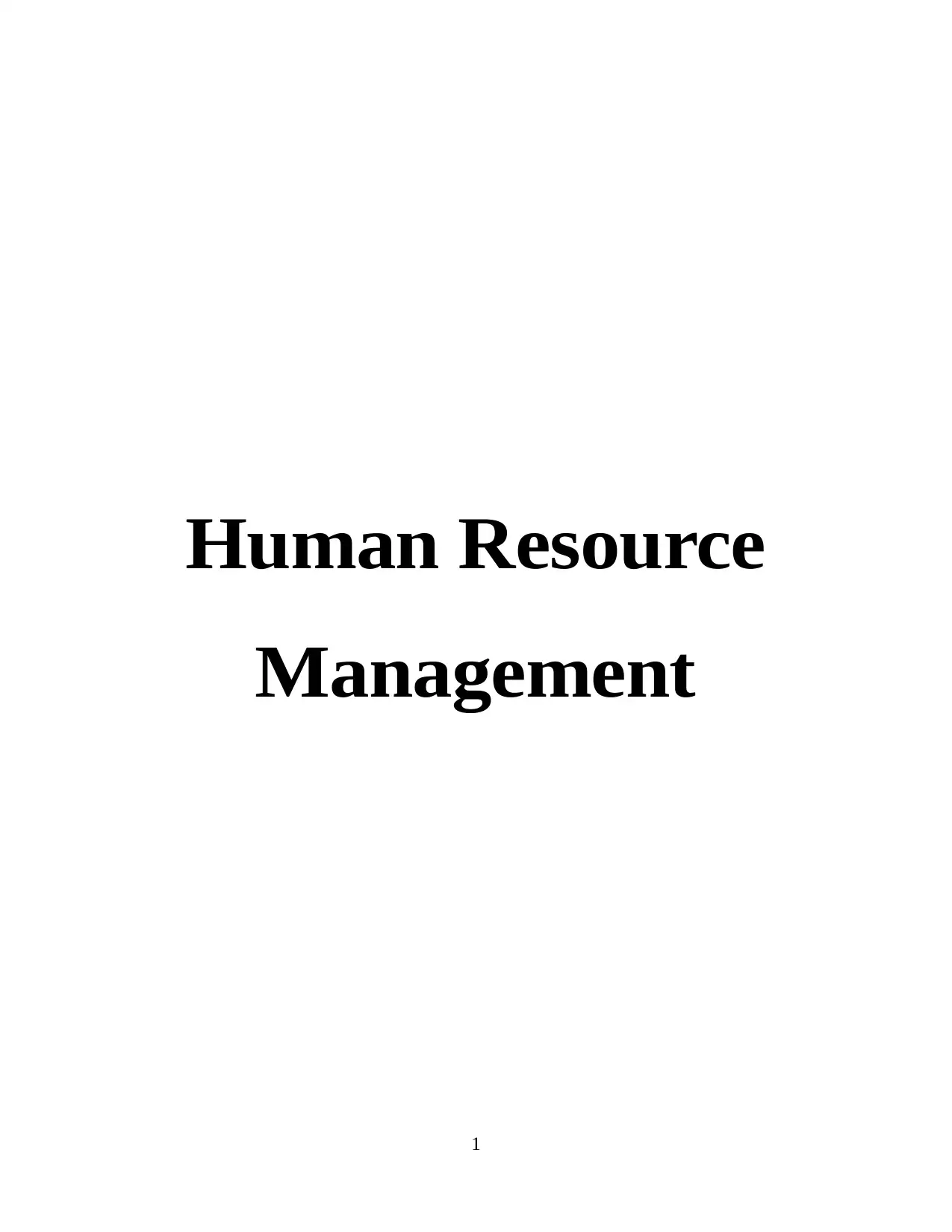
Human Resource
Management
1
Management
1
Paraphrase This Document
Need a fresh take? Get an instant paraphrase of this document with our AI Paraphraser

2
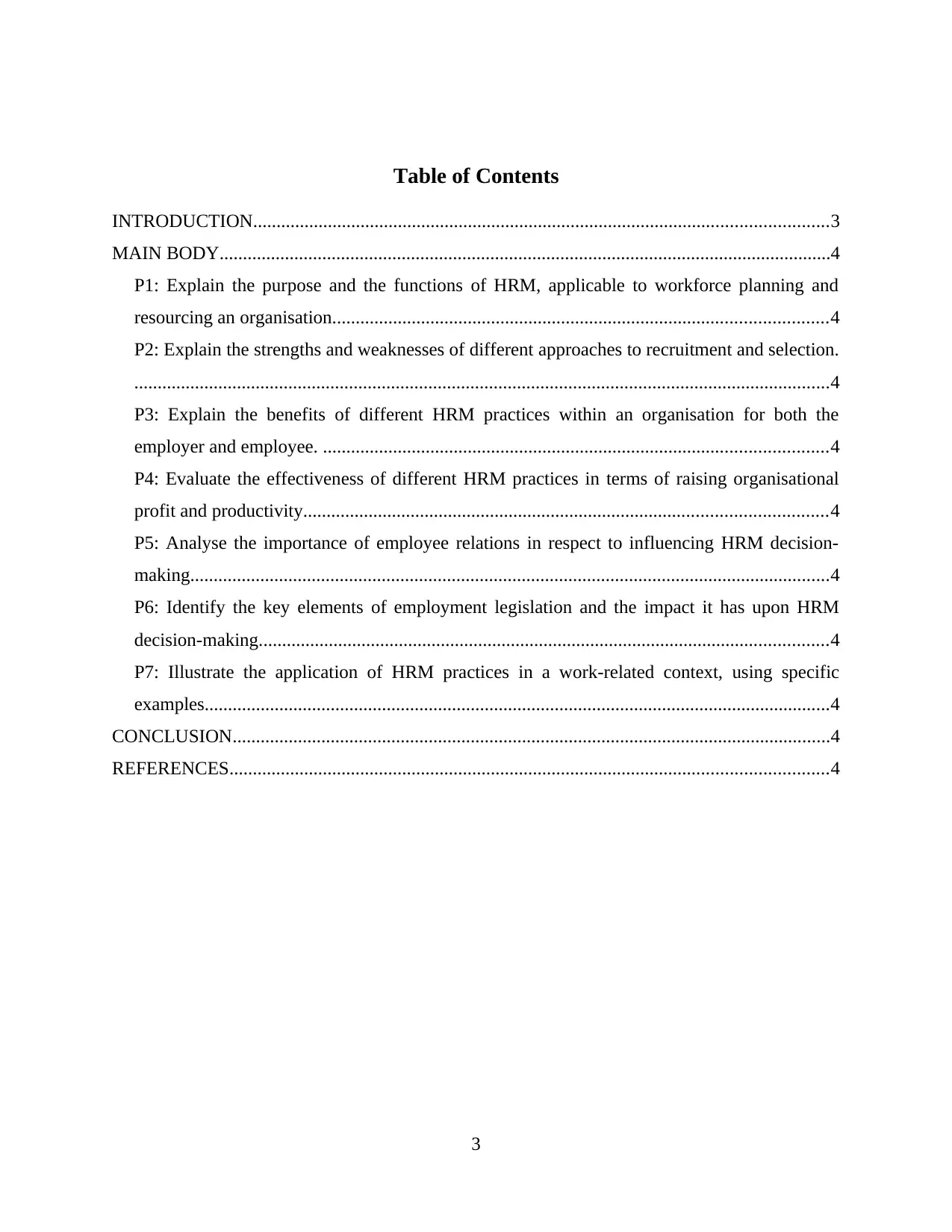
Table of Contents
INTRODUCTION...........................................................................................................................3
MAIN BODY...................................................................................................................................4
P1: Explain the purpose and the functions of HRM, applicable to workforce planning and
resourcing an organisation..........................................................................................................4
P2: Explain the strengths and weaknesses of different approaches to recruitment and selection.
.....................................................................................................................................................4
P3: Explain the benefits of different HRM practices within an organisation for both the
employer and employee. ............................................................................................................4
P4: Evaluate the effectiveness of different HRM practices in terms of raising organisational
profit and productivity................................................................................................................4
P5: Analyse the importance of employee relations in respect to influencing HRM decision-
making.........................................................................................................................................4
P6: Identify the key elements of employment legislation and the impact it has upon HRM
decision-making..........................................................................................................................4
P7: Illustrate the application of HRM practices in a work-related context, using specific
examples......................................................................................................................................4
CONCLUSION................................................................................................................................4
REFERENCES................................................................................................................................4
3
INTRODUCTION...........................................................................................................................3
MAIN BODY...................................................................................................................................4
P1: Explain the purpose and the functions of HRM, applicable to workforce planning and
resourcing an organisation..........................................................................................................4
P2: Explain the strengths and weaknesses of different approaches to recruitment and selection.
.....................................................................................................................................................4
P3: Explain the benefits of different HRM practices within an organisation for both the
employer and employee. ............................................................................................................4
P4: Evaluate the effectiveness of different HRM practices in terms of raising organisational
profit and productivity................................................................................................................4
P5: Analyse the importance of employee relations in respect to influencing HRM decision-
making.........................................................................................................................................4
P6: Identify the key elements of employment legislation and the impact it has upon HRM
decision-making..........................................................................................................................4
P7: Illustrate the application of HRM practices in a work-related context, using specific
examples......................................................................................................................................4
CONCLUSION................................................................................................................................4
REFERENCES................................................................................................................................4
3
You're viewing a preview
Unlock full access by subscribing today!
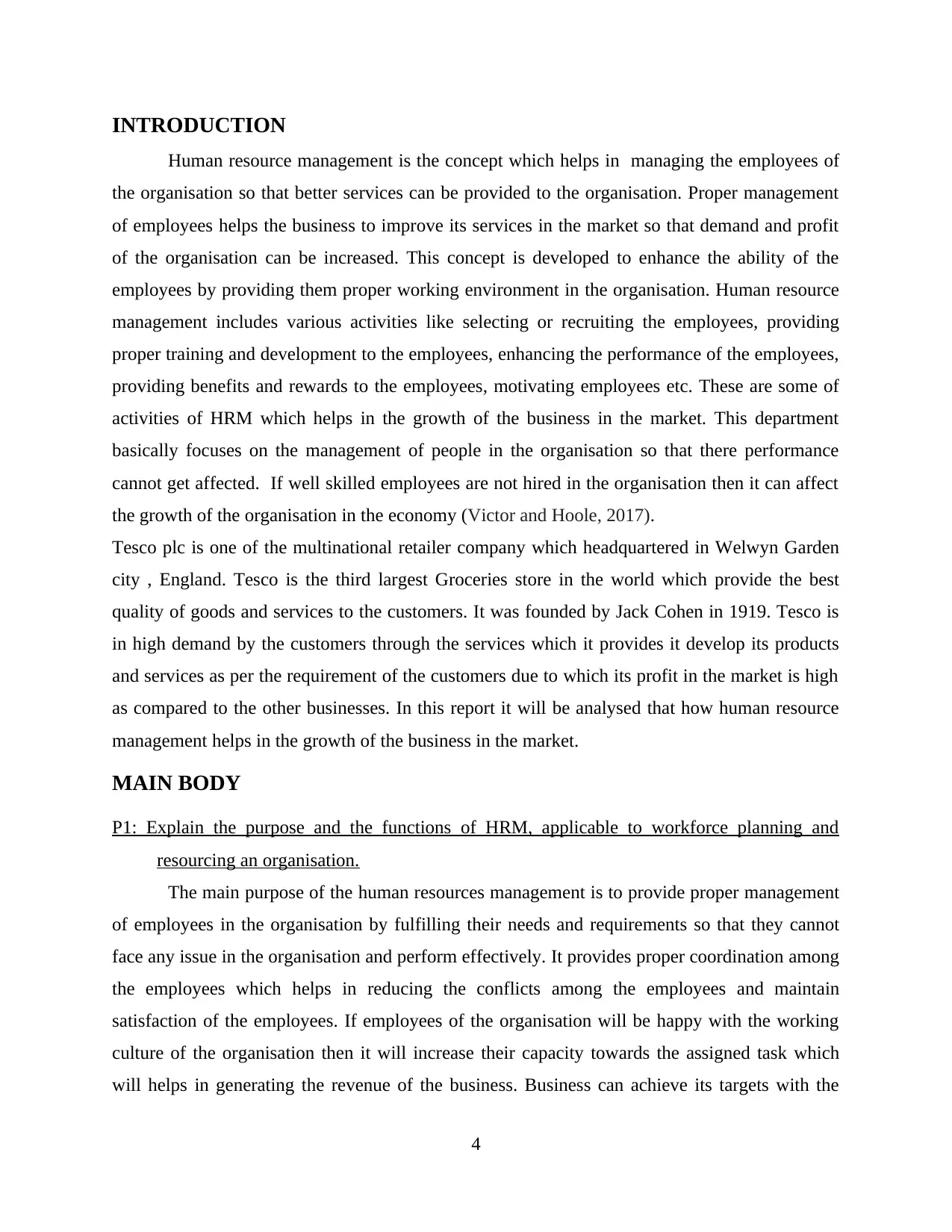
INTRODUCTION
Human resource management is the concept which helps in managing the employees of
the organisation so that better services can be provided to the organisation. Proper management
of employees helps the business to improve its services in the market so that demand and profit
of the organisation can be increased. This concept is developed to enhance the ability of the
employees by providing them proper working environment in the organisation. Human resource
management includes various activities like selecting or recruiting the employees, providing
proper training and development to the employees, enhancing the performance of the employees,
providing benefits and rewards to the employees, motivating employees etc. These are some of
activities of HRM which helps in the growth of the business in the market. This department
basically focuses on the management of people in the organisation so that there performance
cannot get affected. If well skilled employees are not hired in the organisation then it can affect
the growth of the organisation in the economy (Victor and Hoole, 2017).
Tesco plc is one of the multinational retailer company which headquartered in Welwyn Garden
city , England. Tesco is the third largest Groceries store in the world which provide the best
quality of goods and services to the customers. It was founded by Jack Cohen in 1919. Tesco is
in high demand by the customers through the services which it provides it develop its products
and services as per the requirement of the customers due to which its profit in the market is high
as compared to the other businesses. In this report it will be analysed that how human resource
management helps in the growth of the business in the market.
MAIN BODY
P1: Explain the purpose and the functions of HRM, applicable to workforce planning and
resourcing an organisation.
The main purpose of the human resources management is to provide proper management
of employees in the organisation by fulfilling their needs and requirements so that they cannot
face any issue in the organisation and perform effectively. It provides proper coordination among
the employees which helps in reducing the conflicts among the employees and maintain
satisfaction of the employees. If employees of the organisation will be happy with the working
culture of the organisation then it will increase their capacity towards the assigned task which
will helps in generating the revenue of the business. Business can achieve its targets with the
4
Human resource management is the concept which helps in managing the employees of
the organisation so that better services can be provided to the organisation. Proper management
of employees helps the business to improve its services in the market so that demand and profit
of the organisation can be increased. This concept is developed to enhance the ability of the
employees by providing them proper working environment in the organisation. Human resource
management includes various activities like selecting or recruiting the employees, providing
proper training and development to the employees, enhancing the performance of the employees,
providing benefits and rewards to the employees, motivating employees etc. These are some of
activities of HRM which helps in the growth of the business in the market. This department
basically focuses on the management of people in the organisation so that there performance
cannot get affected. If well skilled employees are not hired in the organisation then it can affect
the growth of the organisation in the economy (Victor and Hoole, 2017).
Tesco plc is one of the multinational retailer company which headquartered in Welwyn Garden
city , England. Tesco is the third largest Groceries store in the world which provide the best
quality of goods and services to the customers. It was founded by Jack Cohen in 1919. Tesco is
in high demand by the customers through the services which it provides it develop its products
and services as per the requirement of the customers due to which its profit in the market is high
as compared to the other businesses. In this report it will be analysed that how human resource
management helps in the growth of the business in the market.
MAIN BODY
P1: Explain the purpose and the functions of HRM, applicable to workforce planning and
resourcing an organisation.
The main purpose of the human resources management is to provide proper management
of employees in the organisation by fulfilling their needs and requirements so that they cannot
face any issue in the organisation and perform effectively. It provides proper coordination among
the employees which helps in reducing the conflicts among the employees and maintain
satisfaction of the employees. If employees of the organisation will be happy with the working
culture of the organisation then it will increase their capacity towards the assigned task which
will helps in generating the revenue of the business. Business can achieve its targets with the
4
Paraphrase This Document
Need a fresh take? Get an instant paraphrase of this document with our AI Paraphraser
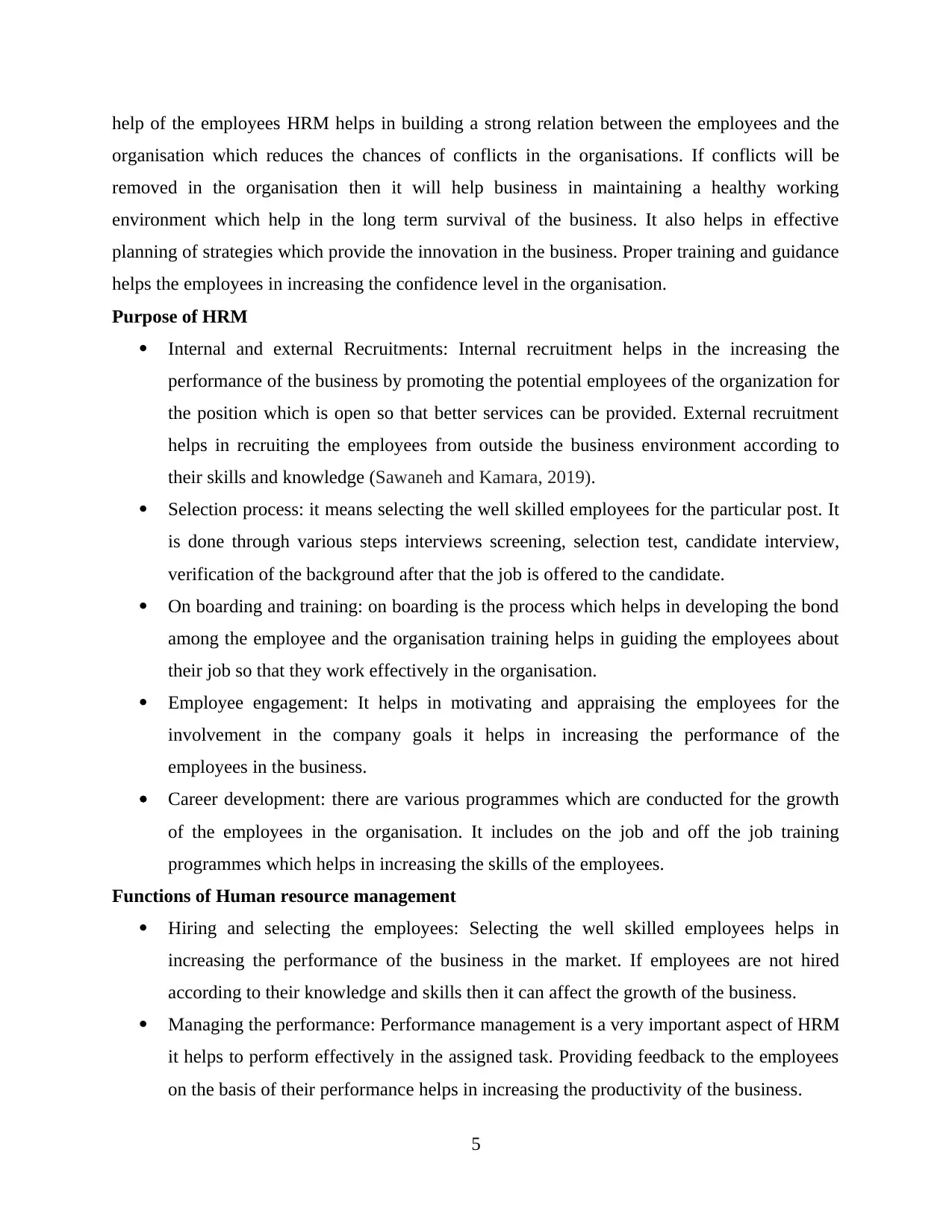
help of the employees HRM helps in building a strong relation between the employees and the
organisation which reduces the chances of conflicts in the organisations. If conflicts will be
removed in the organisation then it will help business in maintaining a healthy working
environment which help in the long term survival of the business. It also helps in effective
planning of strategies which provide the innovation in the business. Proper training and guidance
helps the employees in increasing the confidence level in the organisation.
Purpose of HRM
Internal and external Recruitments: Internal recruitment helps in the increasing the
performance of the business by promoting the potential employees of the organization for
the position which is open so that better services can be provided. External recruitment
helps in recruiting the employees from outside the business environment according to
their skills and knowledge (Sawaneh and Kamara, 2019).
Selection process: it means selecting the well skilled employees for the particular post. It
is done through various steps interviews screening, selection test, candidate interview,
verification of the background after that the job is offered to the candidate.
On boarding and training: on boarding is the process which helps in developing the bond
among the employee and the organisation training helps in guiding the employees about
their job so that they work effectively in the organisation.
Employee engagement: It helps in motivating and appraising the employees for the
involvement in the company goals it helps in increasing the performance of the
employees in the business.
Career development: there are various programmes which are conducted for the growth
of the employees in the organisation. It includes on the job and off the job training
programmes which helps in increasing the skills of the employees.
Functions of Human resource management
Hiring and selecting the employees: Selecting the well skilled employees helps in
increasing the performance of the business in the market. If employees are not hired
according to their knowledge and skills then it can affect the growth of the business.
Managing the performance: Performance management is a very important aspect of HRM
it helps to perform effectively in the assigned task. Providing feedback to the employees
on the basis of their performance helps in increasing the productivity of the business.
5
organisation which reduces the chances of conflicts in the organisations. If conflicts will be
removed in the organisation then it will help business in maintaining a healthy working
environment which help in the long term survival of the business. It also helps in effective
planning of strategies which provide the innovation in the business. Proper training and guidance
helps the employees in increasing the confidence level in the organisation.
Purpose of HRM
Internal and external Recruitments: Internal recruitment helps in the increasing the
performance of the business by promoting the potential employees of the organization for
the position which is open so that better services can be provided. External recruitment
helps in recruiting the employees from outside the business environment according to
their skills and knowledge (Sawaneh and Kamara, 2019).
Selection process: it means selecting the well skilled employees for the particular post. It
is done through various steps interviews screening, selection test, candidate interview,
verification of the background after that the job is offered to the candidate.
On boarding and training: on boarding is the process which helps in developing the bond
among the employee and the organisation training helps in guiding the employees about
their job so that they work effectively in the organisation.
Employee engagement: It helps in motivating and appraising the employees for the
involvement in the company goals it helps in increasing the performance of the
employees in the business.
Career development: there are various programmes which are conducted for the growth
of the employees in the organisation. It includes on the job and off the job training
programmes which helps in increasing the skills of the employees.
Functions of Human resource management
Hiring and selecting the employees: Selecting the well skilled employees helps in
increasing the performance of the business in the market. If employees are not hired
according to their knowledge and skills then it can affect the growth of the business.
Managing the performance: Performance management is a very important aspect of HRM
it helps to perform effectively in the assigned task. Providing feedback to the employees
on the basis of their performance helps in increasing the productivity of the business.
5
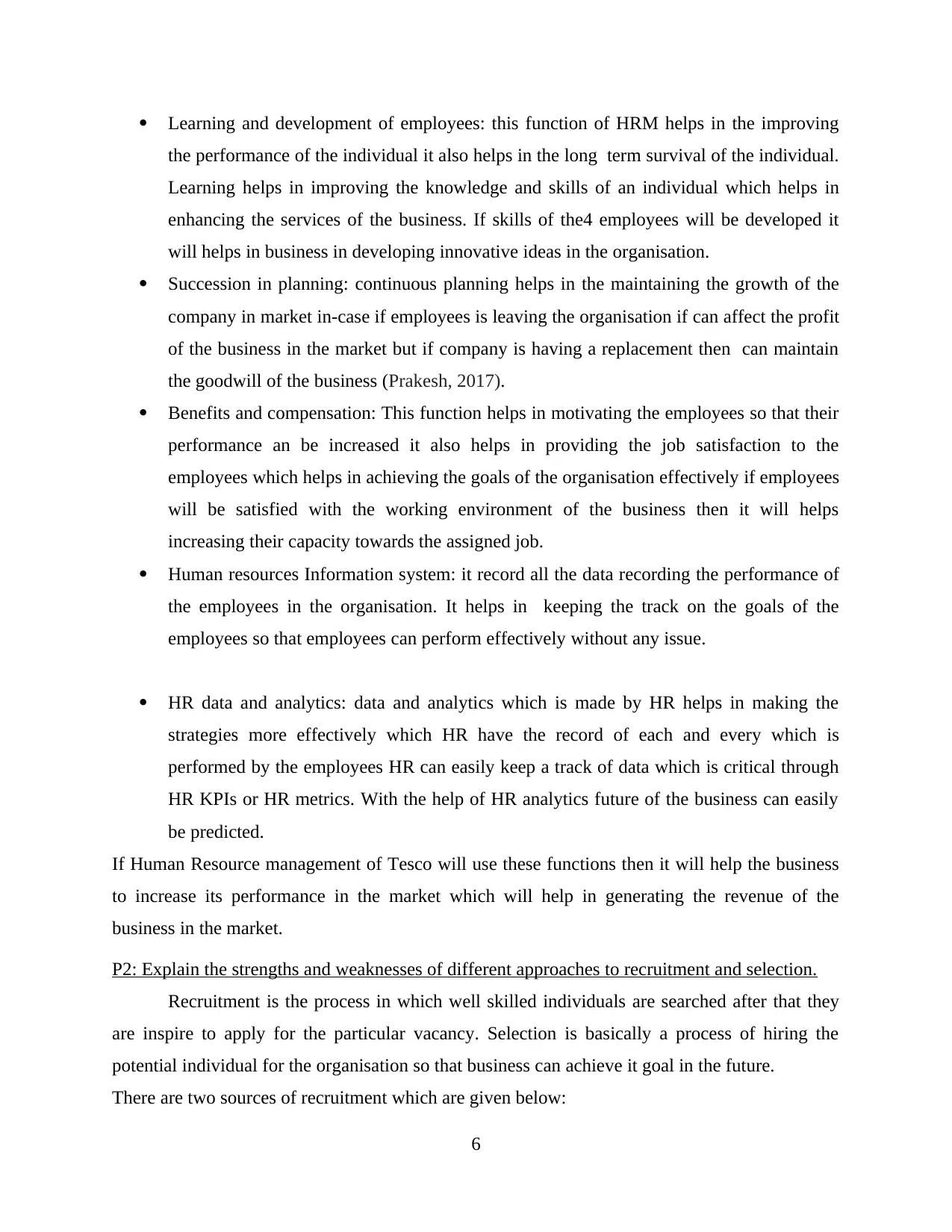
Learning and development of employees: this function of HRM helps in the improving
the performance of the individual it also helps in the long term survival of the individual.
Learning helps in improving the knowledge and skills of an individual which helps in
enhancing the services of the business. If skills of the4 employees will be developed it
will helps in business in developing innovative ideas in the organisation.
Succession in planning: continuous planning helps in the maintaining the growth of the
company in market in-case if employees is leaving the organisation if can affect the profit
of the business in the market but if company is having a replacement then can maintain
the goodwill of the business (Prakesh, 2017).
Benefits and compensation: This function helps in motivating the employees so that their
performance an be increased it also helps in providing the job satisfaction to the
employees which helps in achieving the goals of the organisation effectively if employees
will be satisfied with the working environment of the business then it will helps
increasing their capacity towards the assigned job.
Human resources Information system: it record all the data recording the performance of
the employees in the organisation. It helps in keeping the track on the goals of the
employees so that employees can perform effectively without any issue.
HR data and analytics: data and analytics which is made by HR helps in making the
strategies more effectively which HR have the record of each and every which is
performed by the employees HR can easily keep a track of data which is critical through
HR KPIs or HR metrics. With the help of HR analytics future of the business can easily
be predicted.
If Human Resource management of Tesco will use these functions then it will help the business
to increase its performance in the market which will help in generating the revenue of the
business in the market.
P2: Explain the strengths and weaknesses of different approaches to recruitment and selection.
Recruitment is the process in which well skilled individuals are searched after that they
are inspire to apply for the particular vacancy. Selection is basically a process of hiring the
potential individual for the organisation so that business can achieve it goal in the future.
There are two sources of recruitment which are given below:
6
the performance of the individual it also helps in the long term survival of the individual.
Learning helps in improving the knowledge and skills of an individual which helps in
enhancing the services of the business. If skills of the4 employees will be developed it
will helps in business in developing innovative ideas in the organisation.
Succession in planning: continuous planning helps in the maintaining the growth of the
company in market in-case if employees is leaving the organisation if can affect the profit
of the business in the market but if company is having a replacement then can maintain
the goodwill of the business (Prakesh, 2017).
Benefits and compensation: This function helps in motivating the employees so that their
performance an be increased it also helps in providing the job satisfaction to the
employees which helps in achieving the goals of the organisation effectively if employees
will be satisfied with the working environment of the business then it will helps
increasing their capacity towards the assigned job.
Human resources Information system: it record all the data recording the performance of
the employees in the organisation. It helps in keeping the track on the goals of the
employees so that employees can perform effectively without any issue.
HR data and analytics: data and analytics which is made by HR helps in making the
strategies more effectively which HR have the record of each and every which is
performed by the employees HR can easily keep a track of data which is critical through
HR KPIs or HR metrics. With the help of HR analytics future of the business can easily
be predicted.
If Human Resource management of Tesco will use these functions then it will help the business
to increase its performance in the market which will help in generating the revenue of the
business in the market.
P2: Explain the strengths and weaknesses of different approaches to recruitment and selection.
Recruitment is the process in which well skilled individuals are searched after that they
are inspire to apply for the particular vacancy. Selection is basically a process of hiring the
potential individual for the organisation so that business can achieve it goal in the future.
There are two sources of recruitment which are given below:
6
You're viewing a preview
Unlock full access by subscribing today!
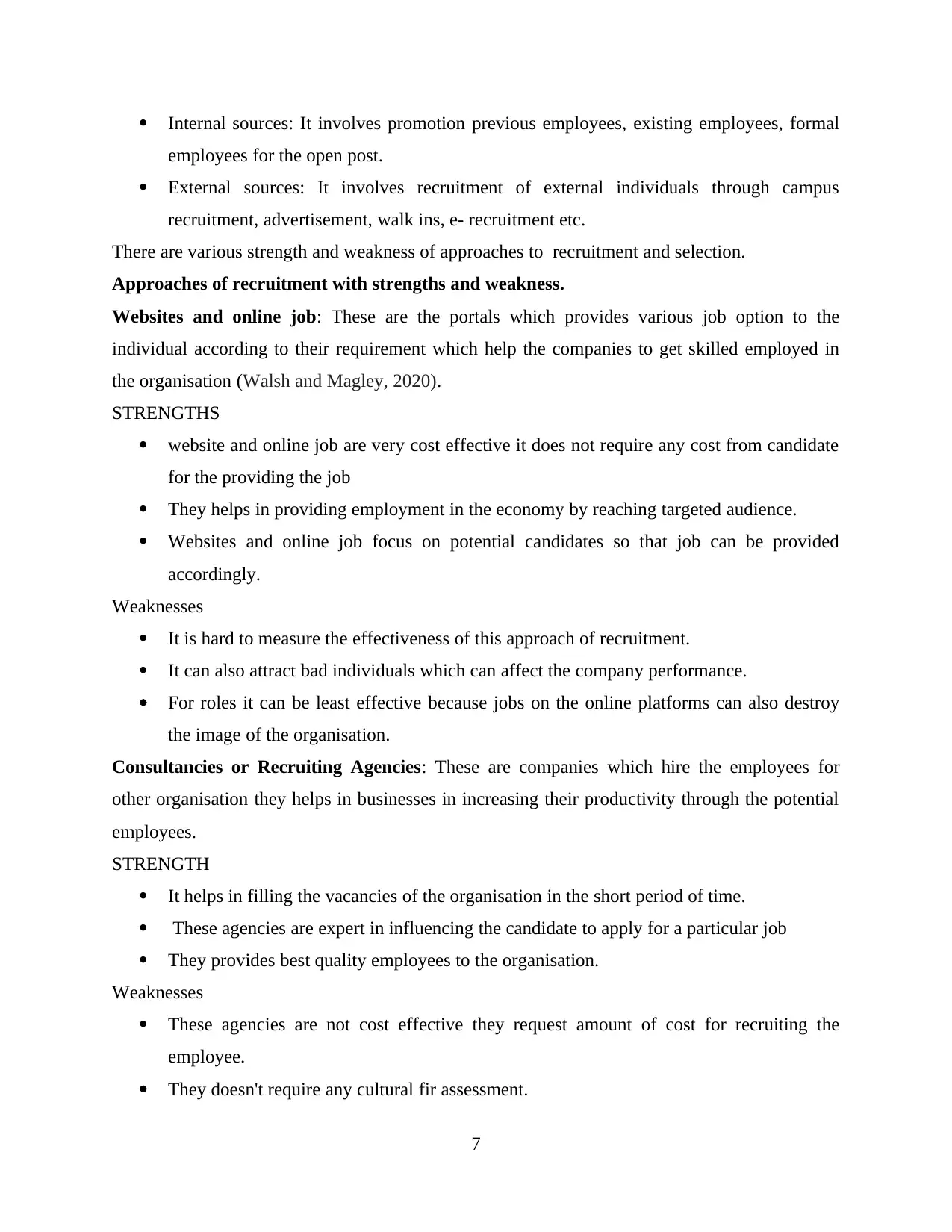
Internal sources: It involves promotion previous employees, existing employees, formal
employees for the open post.
External sources: It involves recruitment of external individuals through campus
recruitment, advertisement, walk ins, e- recruitment etc.
There are various strength and weakness of approaches to recruitment and selection.
Approaches of recruitment with strengths and weakness.
Websites and online job: These are the portals which provides various job option to the
individual according to their requirement which help the companies to get skilled employed in
the organisation (Walsh and Magley, 2020).
STRENGTHS
website and online job are very cost effective it does not require any cost from candidate
for the providing the job
They helps in providing employment in the economy by reaching targeted audience.
Websites and online job focus on potential candidates so that job can be provided
accordingly.
Weaknesses
It is hard to measure the effectiveness of this approach of recruitment.
It can also attract bad individuals which can affect the company performance.
For roles it can be least effective because jobs on the online platforms can also destroy
the image of the organisation.
Consultancies or Recruiting Agencies: These are companies which hire the employees for
other organisation they helps in businesses in increasing their productivity through the potential
employees.
STRENGTH
It helps in filling the vacancies of the organisation in the short period of time.
These agencies are expert in influencing the candidate to apply for a particular job
They provides best quality employees to the organisation.
Weaknesses
These agencies are not cost effective they request amount of cost for recruiting the
employee.
They doesn't require any cultural fir assessment.
7
employees for the open post.
External sources: It involves recruitment of external individuals through campus
recruitment, advertisement, walk ins, e- recruitment etc.
There are various strength and weakness of approaches to recruitment and selection.
Approaches of recruitment with strengths and weakness.
Websites and online job: These are the portals which provides various job option to the
individual according to their requirement which help the companies to get skilled employed in
the organisation (Walsh and Magley, 2020).
STRENGTHS
website and online job are very cost effective it does not require any cost from candidate
for the providing the job
They helps in providing employment in the economy by reaching targeted audience.
Websites and online job focus on potential candidates so that job can be provided
accordingly.
Weaknesses
It is hard to measure the effectiveness of this approach of recruitment.
It can also attract bad individuals which can affect the company performance.
For roles it can be least effective because jobs on the online platforms can also destroy
the image of the organisation.
Consultancies or Recruiting Agencies: These are companies which hire the employees for
other organisation they helps in businesses in increasing their productivity through the potential
employees.
STRENGTH
It helps in filling the vacancies of the organisation in the short period of time.
These agencies are expert in influencing the candidate to apply for a particular job
They provides best quality employees to the organisation.
Weaknesses
These agencies are not cost effective they request amount of cost for recruiting the
employee.
They doesn't require any cultural fir assessment.
7
Paraphrase This Document
Need a fresh take? Get an instant paraphrase of this document with our AI Paraphraser
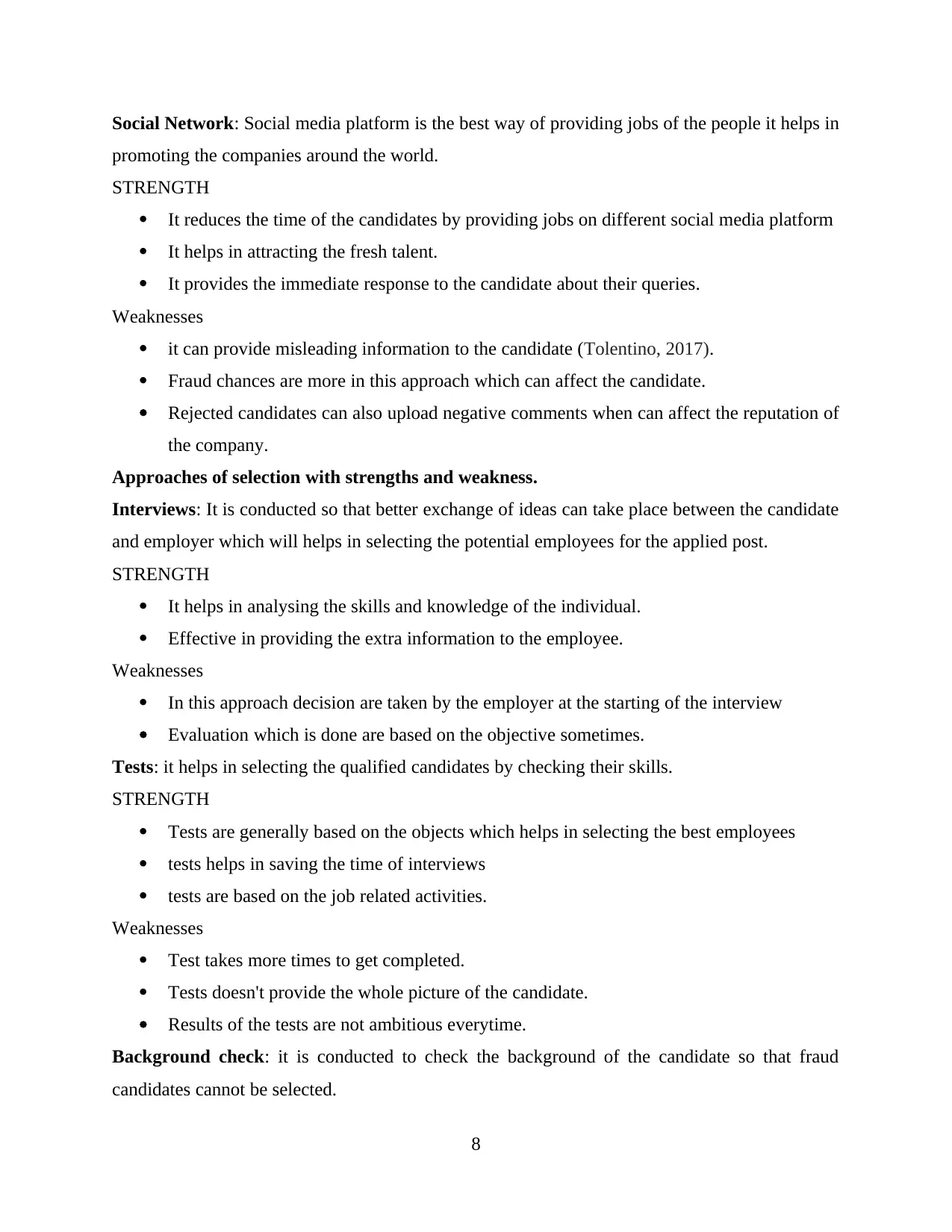
Social Network: Social media platform is the best way of providing jobs of the people it helps in
promoting the companies around the world.
STRENGTH
It reduces the time of the candidates by providing jobs on different social media platform
It helps in attracting the fresh talent.
It provides the immediate response to the candidate about their queries.
Weaknesses
it can provide misleading information to the candidate (Tolentino, 2017).
Fraud chances are more in this approach which can affect the candidate.
Rejected candidates can also upload negative comments when can affect the reputation of
the company.
Approaches of selection with strengths and weakness.
Interviews: It is conducted so that better exchange of ideas can take place between the candidate
and employer which will helps in selecting the potential employees for the applied post.
STRENGTH
It helps in analysing the skills and knowledge of the individual.
Effective in providing the extra information to the employee.
Weaknesses
In this approach decision are taken by the employer at the starting of the interview
Evaluation which is done are based on the objective sometimes.
Tests: it helps in selecting the qualified candidates by checking their skills.
STRENGTH
Tests are generally based on the objects which helps in selecting the best employees
tests helps in saving the time of interviews
tests are based on the job related activities.
Weaknesses
Test takes more times to get completed.
Tests doesn't provide the whole picture of the candidate.
Results of the tests are not ambitious everytime.
Background check: it is conducted to check the background of the candidate so that fraud
candidates cannot be selected.
8
promoting the companies around the world.
STRENGTH
It reduces the time of the candidates by providing jobs on different social media platform
It helps in attracting the fresh talent.
It provides the immediate response to the candidate about their queries.
Weaknesses
it can provide misleading information to the candidate (Tolentino, 2017).
Fraud chances are more in this approach which can affect the candidate.
Rejected candidates can also upload negative comments when can affect the reputation of
the company.
Approaches of selection with strengths and weakness.
Interviews: It is conducted so that better exchange of ideas can take place between the candidate
and employer which will helps in selecting the potential employees for the applied post.
STRENGTH
It helps in analysing the skills and knowledge of the individual.
Effective in providing the extra information to the employee.
Weaknesses
In this approach decision are taken by the employer at the starting of the interview
Evaluation which is done are based on the objective sometimes.
Tests: it helps in selecting the qualified candidates by checking their skills.
STRENGTH
Tests are generally based on the objects which helps in selecting the best employees
tests helps in saving the time of interviews
tests are based on the job related activities.
Weaknesses
Test takes more times to get completed.
Tests doesn't provide the whole picture of the candidate.
Results of the tests are not ambitious everytime.
Background check: it is conducted to check the background of the candidate so that fraud
candidates cannot be selected.
8
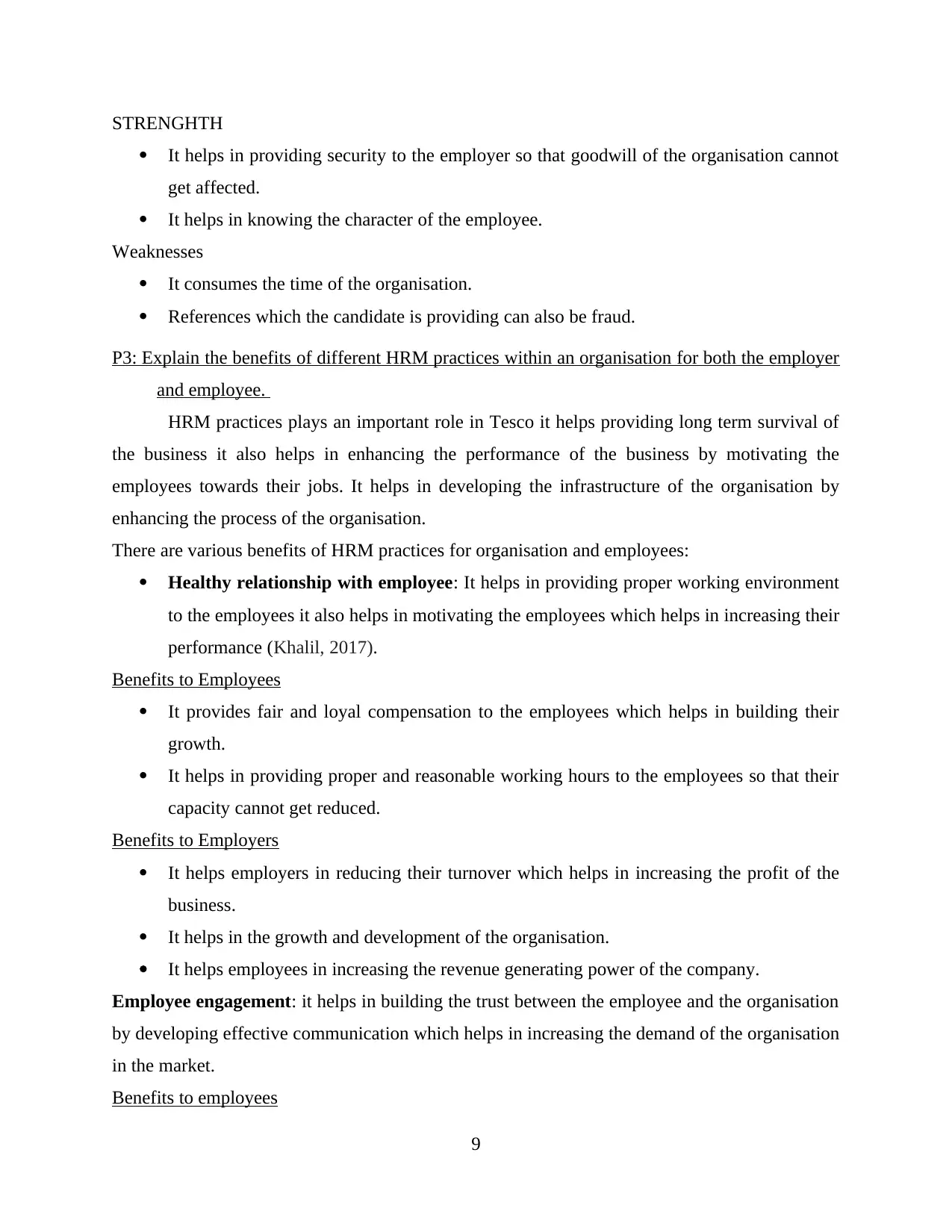
STRENGHTH
It helps in providing security to the employer so that goodwill of the organisation cannot
get affected.
It helps in knowing the character of the employee.
Weaknesses
It consumes the time of the organisation.
References which the candidate is providing can also be fraud.
P3: Explain the benefits of different HRM practices within an organisation for both the employer
and employee.
HRM practices plays an important role in Tesco it helps providing long term survival of
the business it also helps in enhancing the performance of the business by motivating the
employees towards their jobs. It helps in developing the infrastructure of the organisation by
enhancing the process of the organisation.
There are various benefits of HRM practices for organisation and employees:
Healthy relationship with employee: It helps in providing proper working environment
to the employees it also helps in motivating the employees which helps in increasing their
performance (Khalil, 2017).
Benefits to Employees
It provides fair and loyal compensation to the employees which helps in building their
growth.
It helps in providing proper and reasonable working hours to the employees so that their
capacity cannot get reduced.
Benefits to Employers
It helps employers in reducing their turnover which helps in increasing the profit of the
business.
It helps in the growth and development of the organisation.
It helps employees in increasing the revenue generating power of the company.
Employee engagement: it helps in building the trust between the employee and the organisation
by developing effective communication which helps in increasing the demand of the organisation
in the market.
Benefits to employees
9
It helps in providing security to the employer so that goodwill of the organisation cannot
get affected.
It helps in knowing the character of the employee.
Weaknesses
It consumes the time of the organisation.
References which the candidate is providing can also be fraud.
P3: Explain the benefits of different HRM practices within an organisation for both the employer
and employee.
HRM practices plays an important role in Tesco it helps providing long term survival of
the business it also helps in enhancing the performance of the business by motivating the
employees towards their jobs. It helps in developing the infrastructure of the organisation by
enhancing the process of the organisation.
There are various benefits of HRM practices for organisation and employees:
Healthy relationship with employee: It helps in providing proper working environment
to the employees it also helps in motivating the employees which helps in increasing their
performance (Khalil, 2017).
Benefits to Employees
It provides fair and loyal compensation to the employees which helps in building their
growth.
It helps in providing proper and reasonable working hours to the employees so that their
capacity cannot get reduced.
Benefits to Employers
It helps employers in reducing their turnover which helps in increasing the profit of the
business.
It helps in the growth and development of the organisation.
It helps employees in increasing the revenue generating power of the company.
Employee engagement: it helps in building the trust between the employee and the organisation
by developing effective communication which helps in increasing the demand of the organisation
in the market.
Benefits to employees
9
You're viewing a preview
Unlock full access by subscribing today!
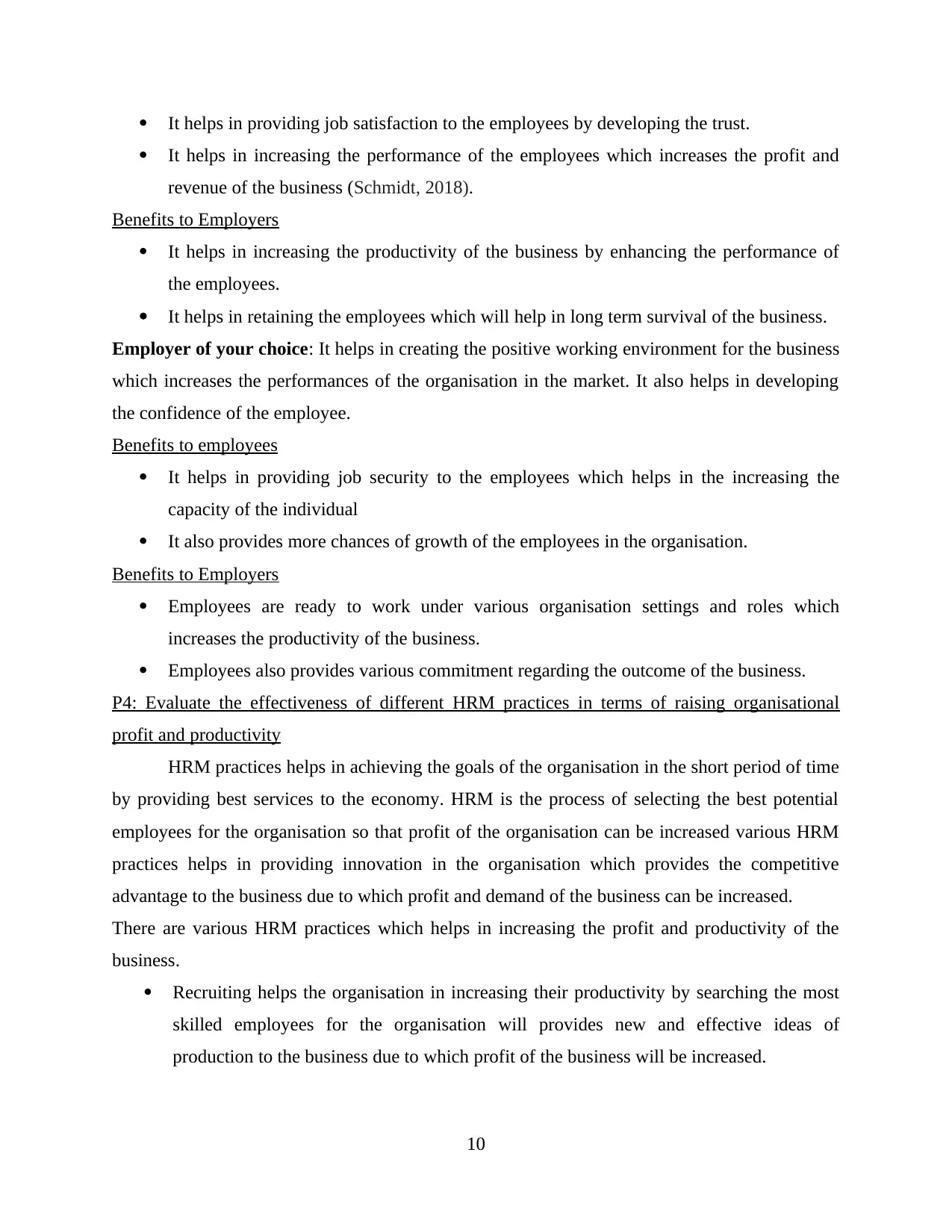
It helps in providing job satisfaction to the employees by developing the trust.
It helps in increasing the performance of the employees which increases the profit and
revenue of the business (Schmidt, 2018).
Benefits to Employers
It helps in increasing the productivity of the business by enhancing the performance of
the employees.
It helps in retaining the employees which will help in long term survival of the business.
Employer of your choice: It helps in creating the positive working environment for the business
which increases the performances of the organisation in the market. It also helps in developing
the confidence of the employee.
Benefits to employees
It helps in providing job security to the employees which helps in the increasing the
capacity of the individual
It also provides more chances of growth of the employees in the organisation.
Benefits to Employers
Employees are ready to work under various organisation settings and roles which
increases the productivity of the business.
Employees also provides various commitment regarding the outcome of the business.
P4: Evaluate the effectiveness of different HRM practices in terms of raising organisational
profit and productivity
HRM practices helps in achieving the goals of the organisation in the short period of time
by providing best services to the economy. HRM is the process of selecting the best potential
employees for the organisation so that profit of the organisation can be increased various HRM
practices helps in providing innovation in the organisation which provides the competitive
advantage to the business due to which profit and demand of the business can be increased.
There are various HRM practices which helps in increasing the profit and productivity of the
business.
Recruiting helps the organisation in increasing their productivity by searching the most
skilled employees for the organisation will provides new and effective ideas of
production to the business due to which profit of the business will be increased.
10
It helps in increasing the performance of the employees which increases the profit and
revenue of the business (Schmidt, 2018).
Benefits to Employers
It helps in increasing the productivity of the business by enhancing the performance of
the employees.
It helps in retaining the employees which will help in long term survival of the business.
Employer of your choice: It helps in creating the positive working environment for the business
which increases the performances of the organisation in the market. It also helps in developing
the confidence of the employee.
Benefits to employees
It helps in providing job security to the employees which helps in the increasing the
capacity of the individual
It also provides more chances of growth of the employees in the organisation.
Benefits to Employers
Employees are ready to work under various organisation settings and roles which
increases the productivity of the business.
Employees also provides various commitment regarding the outcome of the business.
P4: Evaluate the effectiveness of different HRM practices in terms of raising organisational
profit and productivity
HRM practices helps in achieving the goals of the organisation in the short period of time
by providing best services to the economy. HRM is the process of selecting the best potential
employees for the organisation so that profit of the organisation can be increased various HRM
practices helps in providing innovation in the organisation which provides the competitive
advantage to the business due to which profit and demand of the business can be increased.
There are various HRM practices which helps in increasing the profit and productivity of the
business.
Recruiting helps the organisation in increasing their productivity by searching the most
skilled employees for the organisation will provides new and effective ideas of
production to the business due to which profit of the business will be increased.
10
Paraphrase This Document
Need a fresh take? Get an instant paraphrase of this document with our AI Paraphraser
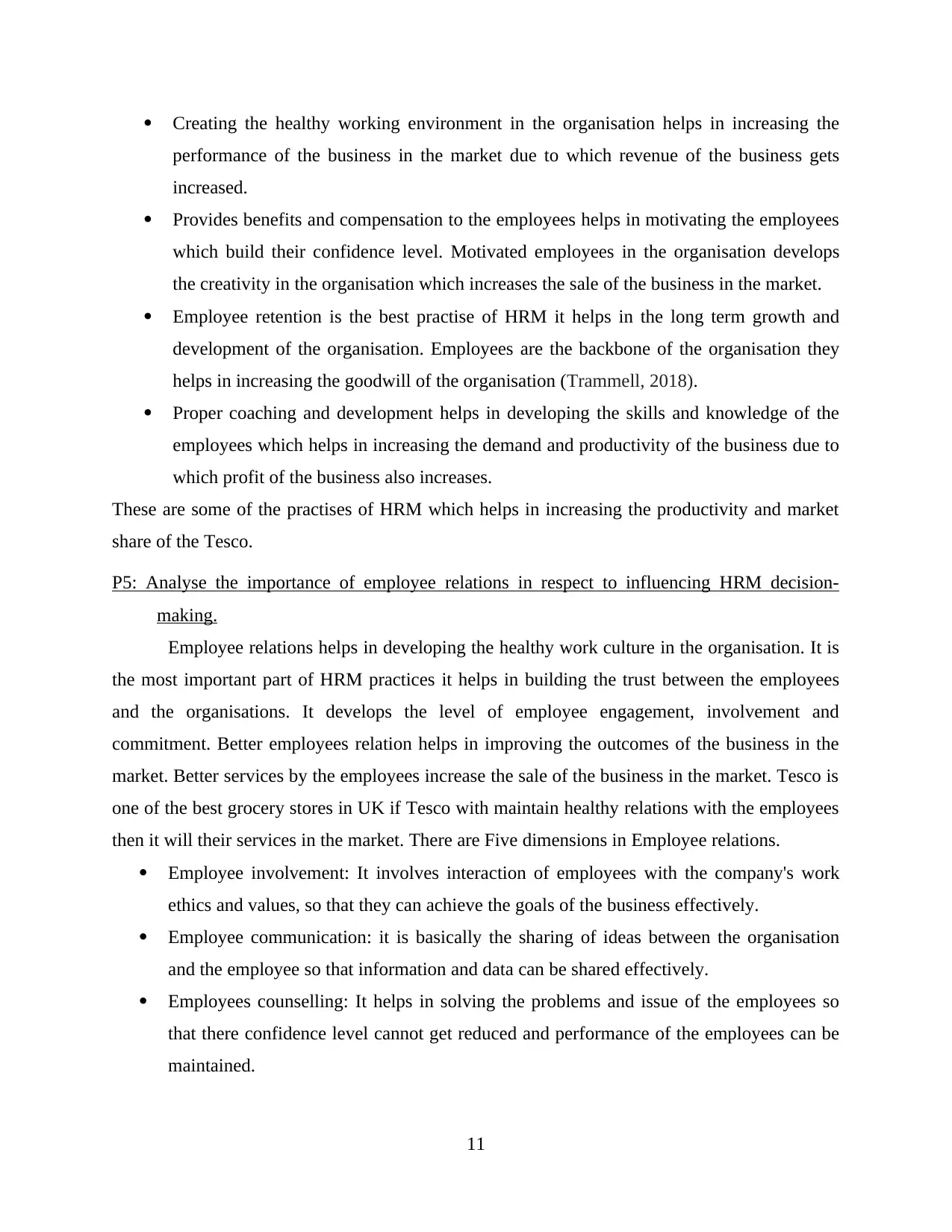
Creating the healthy working environment in the organisation helps in increasing the
performance of the business in the market due to which revenue of the business gets
increased.
Provides benefits and compensation to the employees helps in motivating the employees
which build their confidence level. Motivated employees in the organisation develops
the creativity in the organisation which increases the sale of the business in the market.
Employee retention is the best practise of HRM it helps in the long term growth and
development of the organisation. Employees are the backbone of the organisation they
helps in increasing the goodwill of the organisation (Trammell, 2018).
Proper coaching and development helps in developing the skills and knowledge of the
employees which helps in increasing the demand and productivity of the business due to
which profit of the business also increases.
These are some of the practises of HRM which helps in increasing the productivity and market
share of the Tesco.
P5: Analyse the importance of employee relations in respect to influencing HRM decision-
making.
Employee relations helps in developing the healthy work culture in the organisation. It is
the most important part of HRM practices it helps in building the trust between the employees
and the organisations. It develops the level of employee engagement, involvement and
commitment. Better employees relation helps in improving the outcomes of the business in the
market. Better services by the employees increase the sale of the business in the market. Tesco is
one of the best grocery stores in UK if Tesco with maintain healthy relations with the employees
then it will their services in the market. There are Five dimensions in Employee relations.
Employee involvement: It involves interaction of employees with the company's work
ethics and values, so that they can achieve the goals of the business effectively.
Employee communication: it is basically the sharing of ideas between the organisation
and the employee so that information and data can be shared effectively.
Employees counselling: It helps in solving the problems and issue of the employees so
that there confidence level cannot get reduced and performance of the employees can be
maintained.
11
performance of the business in the market due to which revenue of the business gets
increased.
Provides benefits and compensation to the employees helps in motivating the employees
which build their confidence level. Motivated employees in the organisation develops
the creativity in the organisation which increases the sale of the business in the market.
Employee retention is the best practise of HRM it helps in the long term growth and
development of the organisation. Employees are the backbone of the organisation they
helps in increasing the goodwill of the organisation (Trammell, 2018).
Proper coaching and development helps in developing the skills and knowledge of the
employees which helps in increasing the demand and productivity of the business due to
which profit of the business also increases.
These are some of the practises of HRM which helps in increasing the productivity and market
share of the Tesco.
P5: Analyse the importance of employee relations in respect to influencing HRM decision-
making.
Employee relations helps in developing the healthy work culture in the organisation. It is
the most important part of HRM practices it helps in building the trust between the employees
and the organisations. It develops the level of employee engagement, involvement and
commitment. Better employees relation helps in improving the outcomes of the business in the
market. Better services by the employees increase the sale of the business in the market. Tesco is
one of the best grocery stores in UK if Tesco with maintain healthy relations with the employees
then it will their services in the market. There are Five dimensions in Employee relations.
Employee involvement: It involves interaction of employees with the company's work
ethics and values, so that they can achieve the goals of the business effectively.
Employee communication: it is basically the sharing of ideas between the organisation
and the employee so that information and data can be shared effectively.
Employees counselling: It helps in solving the problems and issue of the employees so
that there confidence level cannot get reduced and performance of the employees can be
maintained.
11
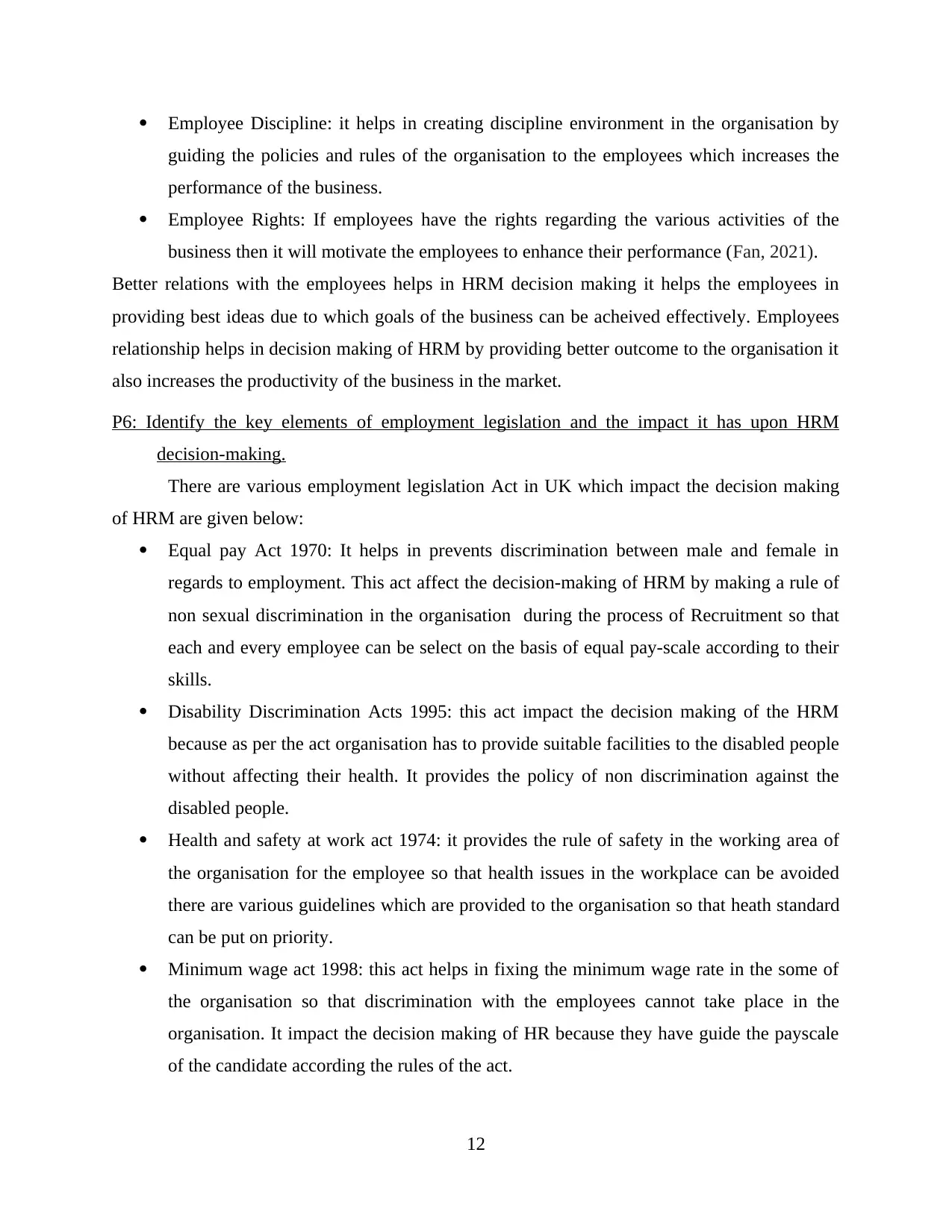
Employee Discipline: it helps in creating discipline environment in the organisation by
guiding the policies and rules of the organisation to the employees which increases the
performance of the business.
Employee Rights: If employees have the rights regarding the various activities of the
business then it will motivate the employees to enhance their performance (Fan, 2021).
Better relations with the employees helps in HRM decision making it helps the employees in
providing best ideas due to which goals of the business can be acheived effectively. Employees
relationship helps in decision making of HRM by providing better outcome to the organisation it
also increases the productivity of the business in the market.
P6: Identify the key elements of employment legislation and the impact it has upon HRM
decision-making.
There are various employment legislation Act in UK which impact the decision making
of HRM are given below:
Equal pay Act 1970: It helps in prevents discrimination between male and female in
regards to employment. This act affect the decision-making of HRM by making a rule of
non sexual discrimination in the organisation during the process of Recruitment so that
each and every employee can be select on the basis of equal pay-scale according to their
skills.
Disability Discrimination Acts 1995: this act impact the decision making of the HRM
because as per the act organisation has to provide suitable facilities to the disabled people
without affecting their health. It provides the policy of non discrimination against the
disabled people.
Health and safety at work act 1974: it provides the rule of safety in the working area of
the organisation for the employee so that health issues in the workplace can be avoided
there are various guidelines which are provided to the organisation so that heath standard
can be put on priority.
Minimum wage act 1998: this act helps in fixing the minimum wage rate in the some of
the organisation so that discrimination with the employees cannot take place in the
organisation. It impact the decision making of HR because they have guide the payscale
of the candidate according the rules of the act.
12
guiding the policies and rules of the organisation to the employees which increases the
performance of the business.
Employee Rights: If employees have the rights regarding the various activities of the
business then it will motivate the employees to enhance their performance (Fan, 2021).
Better relations with the employees helps in HRM decision making it helps the employees in
providing best ideas due to which goals of the business can be acheived effectively. Employees
relationship helps in decision making of HRM by providing better outcome to the organisation it
also increases the productivity of the business in the market.
P6: Identify the key elements of employment legislation and the impact it has upon HRM
decision-making.
There are various employment legislation Act in UK which impact the decision making
of HRM are given below:
Equal pay Act 1970: It helps in prevents discrimination between male and female in
regards to employment. This act affect the decision-making of HRM by making a rule of
non sexual discrimination in the organisation during the process of Recruitment so that
each and every employee can be select on the basis of equal pay-scale according to their
skills.
Disability Discrimination Acts 1995: this act impact the decision making of the HRM
because as per the act organisation has to provide suitable facilities to the disabled people
without affecting their health. It provides the policy of non discrimination against the
disabled people.
Health and safety at work act 1974: it provides the rule of safety in the working area of
the organisation for the employee so that health issues in the workplace can be avoided
there are various guidelines which are provided to the organisation so that heath standard
can be put on priority.
Minimum wage act 1998: this act helps in fixing the minimum wage rate in the some of
the organisation so that discrimination with the employees cannot take place in the
organisation. It impact the decision making of HR because they have guide the payscale
of the candidate according the rules of the act.
12
You're viewing a preview
Unlock full access by subscribing today!
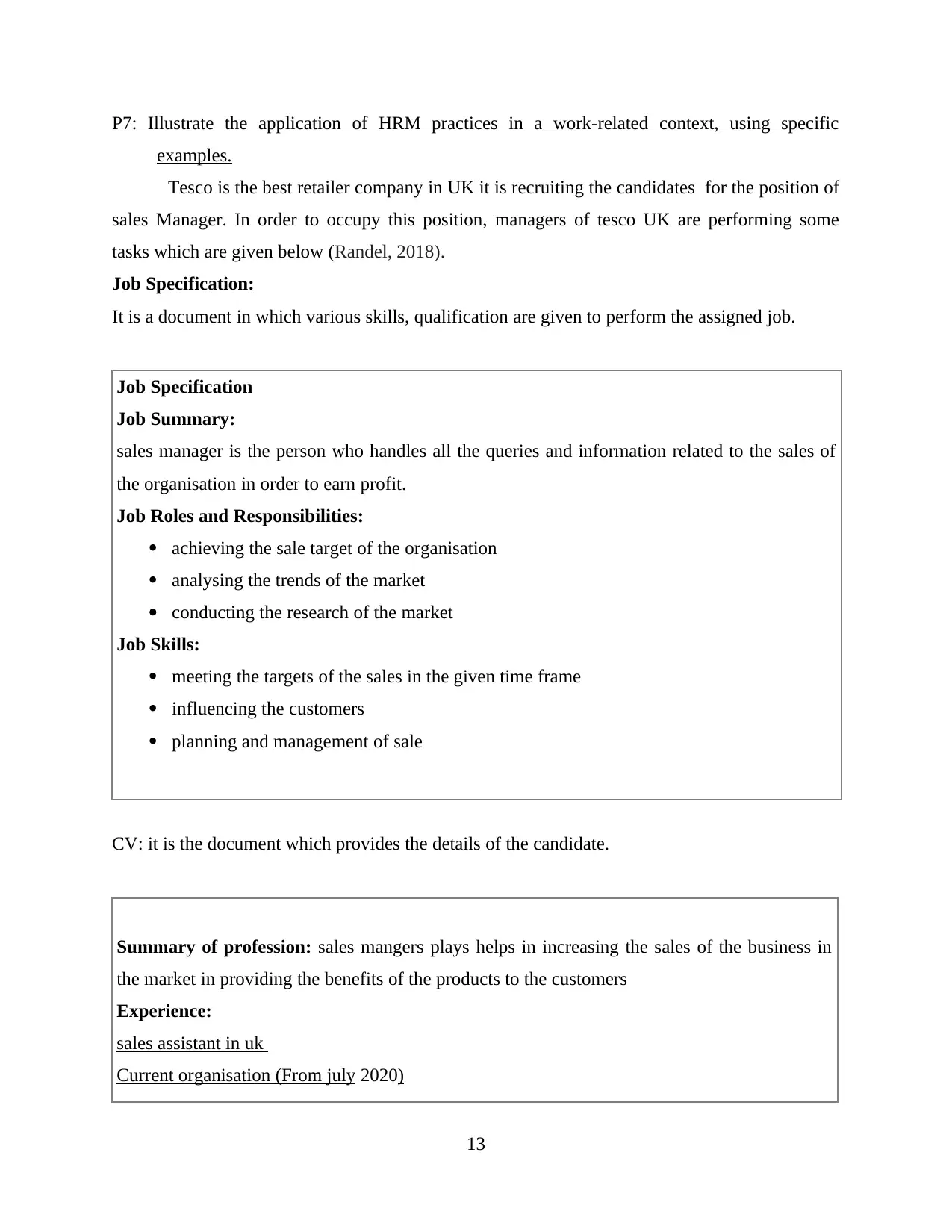
P7: Illustrate the application of HRM practices in a work-related context, using specific
examples.
Tesco is the best retailer company in UK it is recruiting the candidates for the position of
sales Manager. In order to occupy this position, managers of tesco UK are performing some
tasks which are given below (Randel, 2018).
Job Specification:
It is a document in which various skills, qualification are given to perform the assigned job.
Job Specification
Job Summary:
sales manager is the person who handles all the queries and information related to the sales of
the organisation in order to earn profit.
Job Roles and Responsibilities:
achieving the sale target of the organisation
analysing the trends of the market
conducting the research of the market
Job Skills:
meeting the targets of the sales in the given time frame
influencing the customers
planning and management of sale
CV: it is the document which provides the details of the candidate.
Summary of profession: sales mangers plays helps in increasing the sales of the business in
the market in providing the benefits of the products to the customers
Experience:
sales assistant in uk
Current organisation (From july 2020)
13
examples.
Tesco is the best retailer company in UK it is recruiting the candidates for the position of
sales Manager. In order to occupy this position, managers of tesco UK are performing some
tasks which are given below (Randel, 2018).
Job Specification:
It is a document in which various skills, qualification are given to perform the assigned job.
Job Specification
Job Summary:
sales manager is the person who handles all the queries and information related to the sales of
the organisation in order to earn profit.
Job Roles and Responsibilities:
achieving the sale target of the organisation
analysing the trends of the market
conducting the research of the market
Job Skills:
meeting the targets of the sales in the given time frame
influencing the customers
planning and management of sale
CV: it is the document which provides the details of the candidate.
Summary of profession: sales mangers plays helps in increasing the sales of the business in
the market in providing the benefits of the products to the customers
Experience:
sales assistant in uk
Current organisation (From july 2020)
13
Paraphrase This Document
Need a fresh take? Get an instant paraphrase of this document with our AI Paraphraser
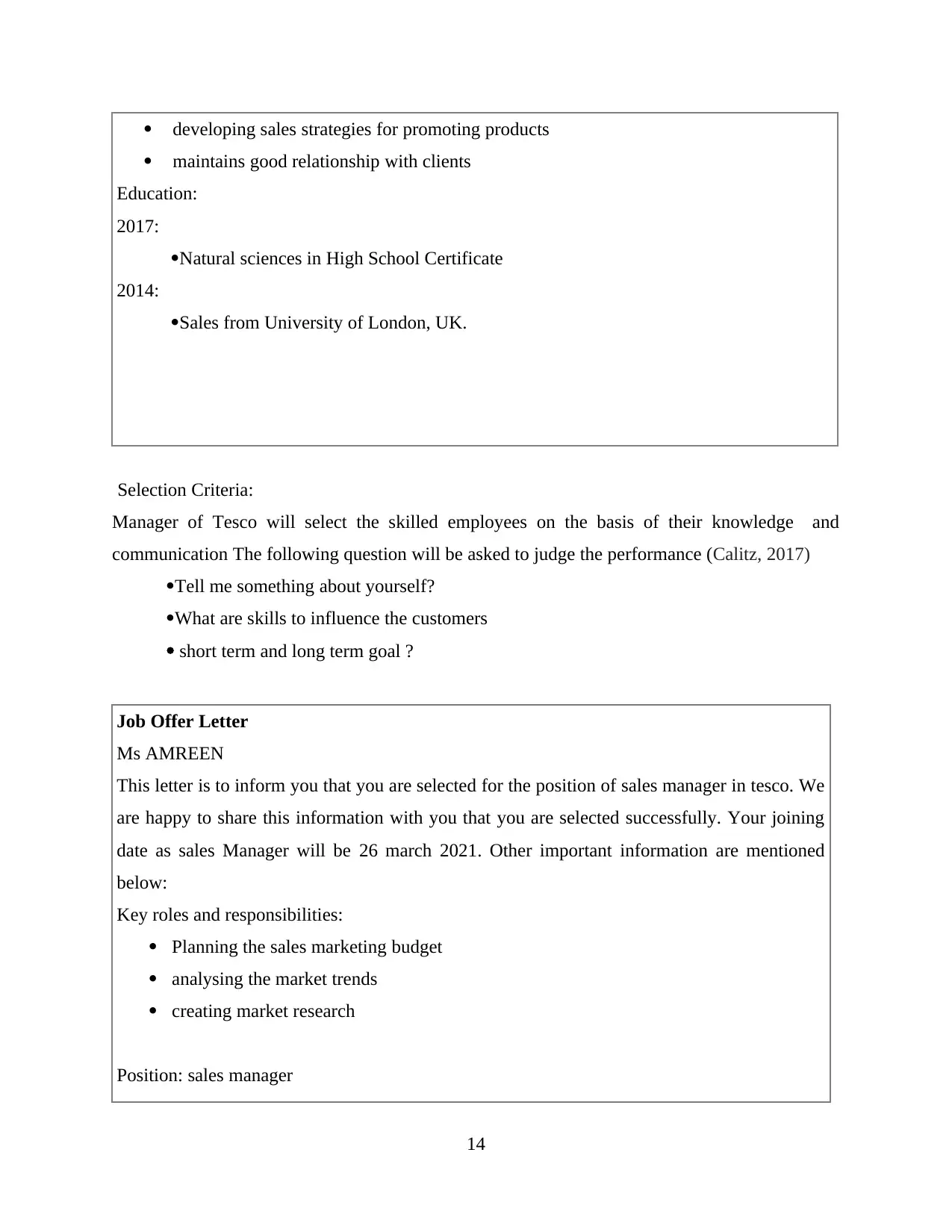
developing sales strategies for promoting products
maintains good relationship with clients
Education:
2017:
Natural sciences in High School Certificate
2014:
Sales from University of London, UK.
Selection Criteria:
Manager of Tesco will select the skilled employees on the basis of their knowledge and
communication The following question will be asked to judge the performance (Calitz, 2017)
Tell me something about yourself?
What are skills to influence the customers
short term and long term goal ?
Job Offer Letter
Ms AMREEN
This letter is to inform you that you are selected for the position of sales manager in tesco. We
are happy to share this information with you that you are selected successfully. Your joining
date as sales Manager will be 26 march 2021. Other important information are mentioned
below:
Key roles and responsibilities:
Planning the sales marketing budget
analysing the market trends
creating market research
Position: sales manager
14
maintains good relationship with clients
Education:
2017:
Natural sciences in High School Certificate
2014:
Sales from University of London, UK.
Selection Criteria:
Manager of Tesco will select the skilled employees on the basis of their knowledge and
communication The following question will be asked to judge the performance (Calitz, 2017)
Tell me something about yourself?
What are skills to influence the customers
short term and long term goal ?
Job Offer Letter
Ms AMREEN
This letter is to inform you that you are selected for the position of sales manager in tesco. We
are happy to share this information with you that you are selected successfully. Your joining
date as sales Manager will be 26 march 2021. Other important information are mentioned
below:
Key roles and responsibilities:
Planning the sales marketing budget
analysing the market trends
creating market research
Position: sales manager
14
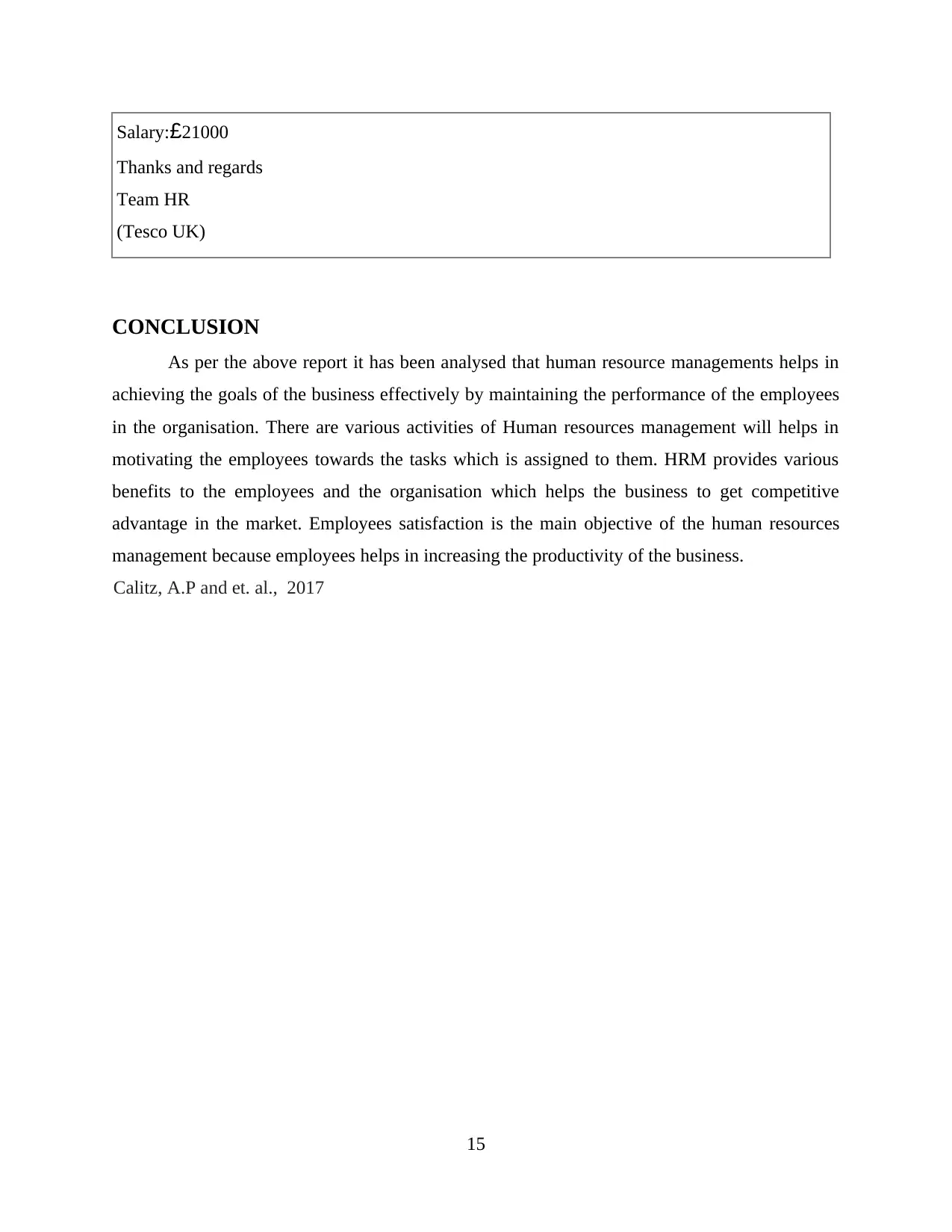
Salary:£21000
Thanks and regards
Team HR
(Tesco UK)
CONCLUSION
As per the above report it has been analysed that human resource managements helps in
achieving the goals of the business effectively by maintaining the performance of the employees
in the organisation. There are various activities of Human resources management will helps in
motivating the employees towards the tasks which is assigned to them. HRM provides various
benefits to the employees and the organisation which helps the business to get competitive
advantage in the market. Employees satisfaction is the main objective of the human resources
management because employees helps in increasing the productivity of the business.
Calitz, A.P and et. al., 2017
15
Thanks and regards
Team HR
(Tesco UK)
CONCLUSION
As per the above report it has been analysed that human resource managements helps in
achieving the goals of the business effectively by maintaining the performance of the employees
in the organisation. There are various activities of Human resources management will helps in
motivating the employees towards the tasks which is assigned to them. HRM provides various
benefits to the employees and the organisation which helps the business to get competitive
advantage in the market. Employees satisfaction is the main objective of the human resources
management because employees helps in increasing the productivity of the business.
Calitz, A.P and et. al., 2017
15
You're viewing a preview
Unlock full access by subscribing today!
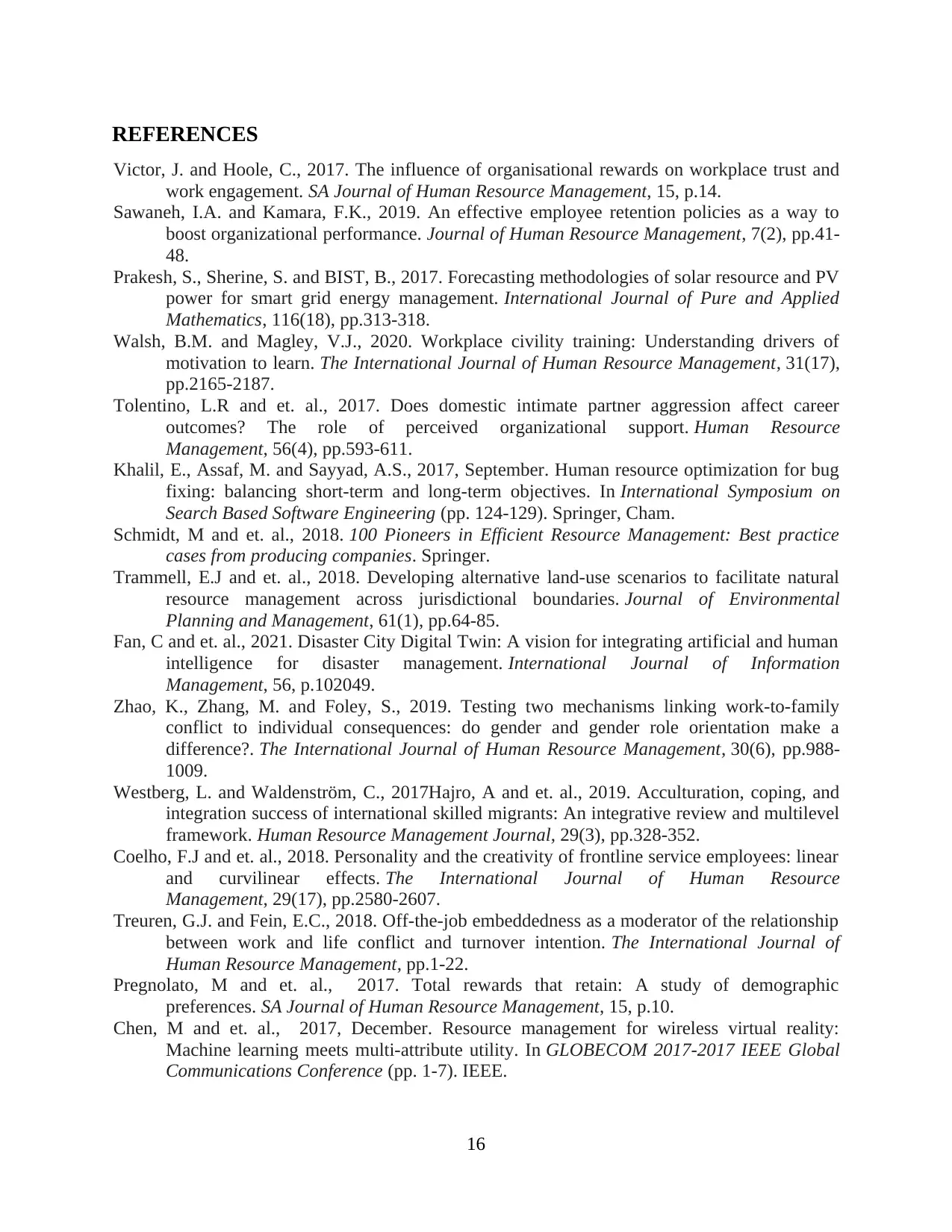
REFERENCES
Victor, J. and Hoole, C., 2017. The influence of organisational rewards on workplace trust and
work engagement. SA Journal of Human Resource Management, 15, p.14.
Sawaneh, I.A. and Kamara, F.K., 2019. An effective employee retention policies as a way to
boost organizational performance. Journal of Human Resource Management, 7(2), pp.41-
48.
Prakesh, S., Sherine, S. and BIST, B., 2017. Forecasting methodologies of solar resource and PV
power for smart grid energy management. International Journal of Pure and Applied
Mathematics, 116(18), pp.313-318.
Walsh, B.M. and Magley, V.J., 2020. Workplace civility training: Understanding drivers of
motivation to learn. The International Journal of Human Resource Management, 31(17),
pp.2165-2187.
Tolentino, L.R and et. al., 2017. Does domestic intimate partner aggression affect career
outcomes? The role of perceived organizational support. Human Resource
Management, 56(4), pp.593-611.
Khalil, E., Assaf, M. and Sayyad, A.S., 2017, September. Human resource optimization for bug
fixing: balancing short-term and long-term objectives. In International Symposium on
Search Based Software Engineering (pp. 124-129). Springer, Cham.
Schmidt, M and et. al., 2018. 100 Pioneers in Efficient Resource Management: Best practice
cases from producing companies. Springer.
Trammell, E.J and et. al., 2018. Developing alternative land-use scenarios to facilitate natural
resource management across jurisdictional boundaries. Journal of Environmental
Planning and Management, 61(1), pp.64-85.
Fan, C and et. al., 2021. Disaster City Digital Twin: A vision for integrating artificial and human
intelligence for disaster management. International Journal of Information
Management, 56, p.102049.
Zhao, K., Zhang, M. and Foley, S., 2019. Testing two mechanisms linking work-to-family
conflict to individual consequences: do gender and gender role orientation make a
difference?. The International Journal of Human Resource Management, 30(6), pp.988-
1009.
Westberg, L. and Waldenström, C., 2017Hajro, A and et. al., 2019. Acculturation, coping, and
integration success of international skilled migrants: An integrative review and multilevel
framework. Human Resource Management Journal, 29(3), pp.328-352.
Coelho, F.J and et. al., 2018. Personality and the creativity of frontline service employees: linear
and curvilinear effects. The International Journal of Human Resource
Management, 29(17), pp.2580-2607.
Treuren, G.J. and Fein, E.C., 2018. Off-the-job embeddedness as a moderator of the relationship
between work and life conflict and turnover intention. The International Journal of
Human Resource Management, pp.1-22.
Pregnolato, M and et. al., 2017. Total rewards that retain: A study of demographic
preferences. SA Journal of Human Resource Management, 15, p.10.
Chen, M and et. al., 2017, December. Resource management for wireless virtual reality:
Machine learning meets multi-attribute utility. In GLOBECOM 2017-2017 IEEE Global
Communications Conference (pp. 1-7). IEEE.
16
Victor, J. and Hoole, C., 2017. The influence of organisational rewards on workplace trust and
work engagement. SA Journal of Human Resource Management, 15, p.14.
Sawaneh, I.A. and Kamara, F.K., 2019. An effective employee retention policies as a way to
boost organizational performance. Journal of Human Resource Management, 7(2), pp.41-
48.
Prakesh, S., Sherine, S. and BIST, B., 2017. Forecasting methodologies of solar resource and PV
power for smart grid energy management. International Journal of Pure and Applied
Mathematics, 116(18), pp.313-318.
Walsh, B.M. and Magley, V.J., 2020. Workplace civility training: Understanding drivers of
motivation to learn. The International Journal of Human Resource Management, 31(17),
pp.2165-2187.
Tolentino, L.R and et. al., 2017. Does domestic intimate partner aggression affect career
outcomes? The role of perceived organizational support. Human Resource
Management, 56(4), pp.593-611.
Khalil, E., Assaf, M. and Sayyad, A.S., 2017, September. Human resource optimization for bug
fixing: balancing short-term and long-term objectives. In International Symposium on
Search Based Software Engineering (pp. 124-129). Springer, Cham.
Schmidt, M and et. al., 2018. 100 Pioneers in Efficient Resource Management: Best practice
cases from producing companies. Springer.
Trammell, E.J and et. al., 2018. Developing alternative land-use scenarios to facilitate natural
resource management across jurisdictional boundaries. Journal of Environmental
Planning and Management, 61(1), pp.64-85.
Fan, C and et. al., 2021. Disaster City Digital Twin: A vision for integrating artificial and human
intelligence for disaster management. International Journal of Information
Management, 56, p.102049.
Zhao, K., Zhang, M. and Foley, S., 2019. Testing two mechanisms linking work-to-family
conflict to individual consequences: do gender and gender role orientation make a
difference?. The International Journal of Human Resource Management, 30(6), pp.988-
1009.
Westberg, L. and Waldenström, C., 2017Hajro, A and et. al., 2019. Acculturation, coping, and
integration success of international skilled migrants: An integrative review and multilevel
framework. Human Resource Management Journal, 29(3), pp.328-352.
Coelho, F.J and et. al., 2018. Personality and the creativity of frontline service employees: linear
and curvilinear effects. The International Journal of Human Resource
Management, 29(17), pp.2580-2607.
Treuren, G.J. and Fein, E.C., 2018. Off-the-job embeddedness as a moderator of the relationship
between work and life conflict and turnover intention. The International Journal of
Human Resource Management, pp.1-22.
Pregnolato, M and et. al., 2017. Total rewards that retain: A study of demographic
preferences. SA Journal of Human Resource Management, 15, p.10.
Chen, M and et. al., 2017, December. Resource management for wireless virtual reality:
Machine learning meets multi-attribute utility. In GLOBECOM 2017-2017 IEEE Global
Communications Conference (pp. 1-7). IEEE.
16
Paraphrase This Document
Need a fresh take? Get an instant paraphrase of this document with our AI Paraphraser
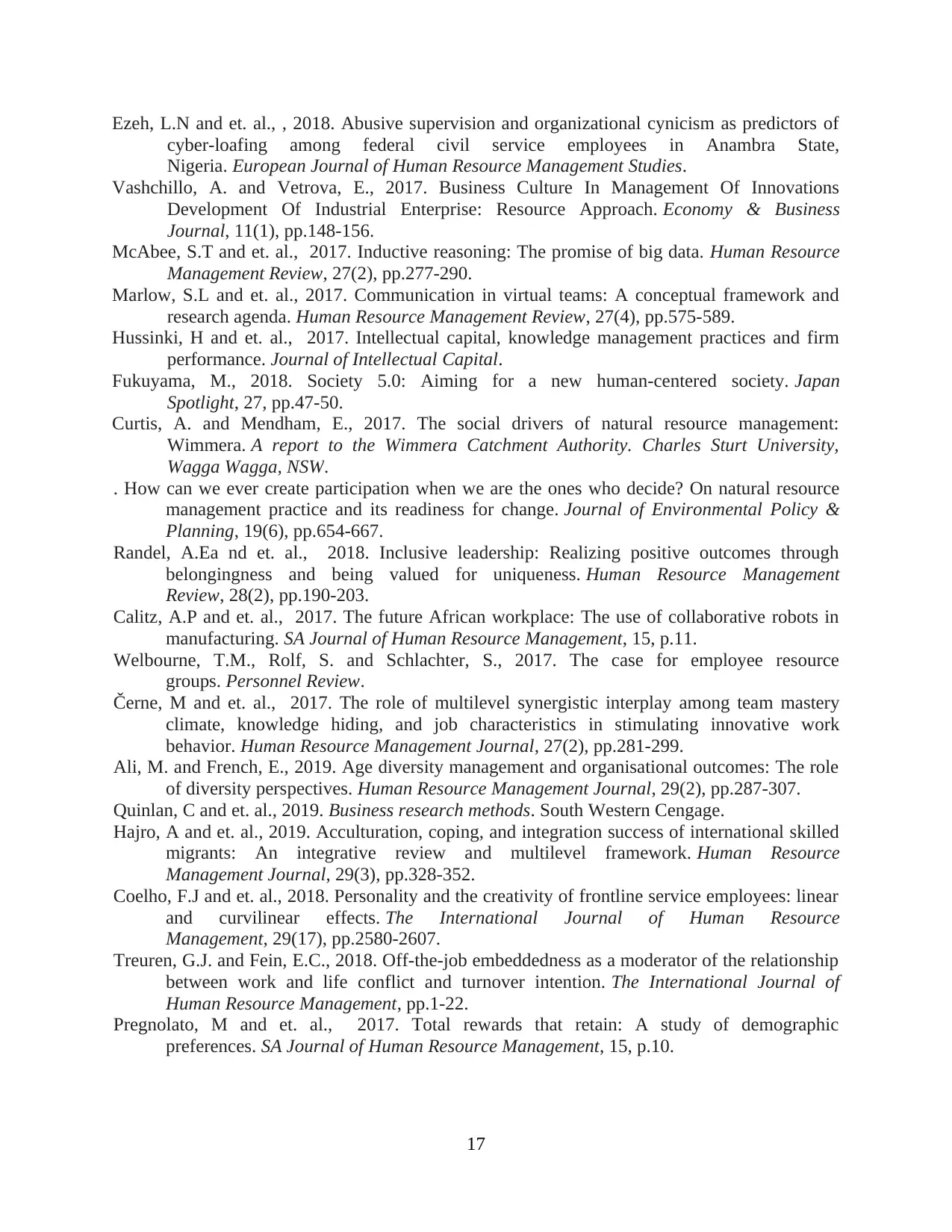
Ezeh, L.N and et. al., , 2018. Abusive supervision and organizational cynicism as predictors of
cyber-loafing among federal civil service employees in Anambra State,
Nigeria. European Journal of Human Resource Management Studies.
Vashchillo, A. and Vetrova, E., 2017. Business Culture In Management Of Innovations
Development Of Industrial Enterprise: Resource Approach. Economy & Business
Journal, 11(1), pp.148-156.
McAbee, S.T and et. al., 2017. Inductive reasoning: The promise of big data. Human Resource
Management Review, 27(2), pp.277-290.
Marlow, S.L and et. al., 2017. Communication in virtual teams: A conceptual framework and
research agenda. Human Resource Management Review, 27(4), pp.575-589.
Hussinki, H and et. al., 2017. Intellectual capital, knowledge management practices and firm
performance. Journal of Intellectual Capital.
Fukuyama, M., 2018. Society 5.0: Aiming for a new human-centered society. Japan
Spotlight, 27, pp.47-50.
Curtis, A. and Mendham, E., 2017. The social drivers of natural resource management:
Wimmera. A report to the Wimmera Catchment Authority. Charles Sturt University,
Wagga Wagga, NSW.
. How can we ever create participation when we are the ones who decide? On natural resource
management practice and its readiness for change. Journal of Environmental Policy &
Planning, 19(6), pp.654-667.
Randel, A.Ea nd et. al., 2018. Inclusive leadership: Realizing positive outcomes through
belongingness and being valued for uniqueness. Human Resource Management
Review, 28(2), pp.190-203.
Calitz, A.P and et. al., 2017. The future African workplace: The use of collaborative robots in
manufacturing. SA Journal of Human Resource Management, 15, p.11.
Welbourne, T.M., Rolf, S. and Schlachter, S., 2017. The case for employee resource
groups. Personnel Review.
Černe, M and et. al., 2017. The role of multilevel synergistic interplay among team mastery
climate, knowledge hiding, and job characteristics in stimulating innovative work
behavior. Human Resource Management Journal, 27(2), pp.281-299.
Ali, M. and French, E., 2019. Age diversity management and organisational outcomes: The role
of diversity perspectives. Human Resource Management Journal, 29(2), pp.287-307.
Quinlan, C and et. al., 2019. Business research methods. South Western Cengage.
Hajro, A and et. al., 2019. Acculturation, coping, and integration success of international skilled
migrants: An integrative review and multilevel framework. Human Resource
Management Journal, 29(3), pp.328-352.
Coelho, F.J and et. al., 2018. Personality and the creativity of frontline service employees: linear
and curvilinear effects. The International Journal of Human Resource
Management, 29(17), pp.2580-2607.
Treuren, G.J. and Fein, E.C., 2018. Off-the-job embeddedness as a moderator of the relationship
between work and life conflict and turnover intention. The International Journal of
Human Resource Management, pp.1-22.
Pregnolato, M and et. al., 2017. Total rewards that retain: A study of demographic
preferences. SA Journal of Human Resource Management, 15, p.10.
17
cyber-loafing among federal civil service employees in Anambra State,
Nigeria. European Journal of Human Resource Management Studies.
Vashchillo, A. and Vetrova, E., 2017. Business Culture In Management Of Innovations
Development Of Industrial Enterprise: Resource Approach. Economy & Business
Journal, 11(1), pp.148-156.
McAbee, S.T and et. al., 2017. Inductive reasoning: The promise of big data. Human Resource
Management Review, 27(2), pp.277-290.
Marlow, S.L and et. al., 2017. Communication in virtual teams: A conceptual framework and
research agenda. Human Resource Management Review, 27(4), pp.575-589.
Hussinki, H and et. al., 2017. Intellectual capital, knowledge management practices and firm
performance. Journal of Intellectual Capital.
Fukuyama, M., 2018. Society 5.0: Aiming for a new human-centered society. Japan
Spotlight, 27, pp.47-50.
Curtis, A. and Mendham, E., 2017. The social drivers of natural resource management:
Wimmera. A report to the Wimmera Catchment Authority. Charles Sturt University,
Wagga Wagga, NSW.
. How can we ever create participation when we are the ones who decide? On natural resource
management practice and its readiness for change. Journal of Environmental Policy &
Planning, 19(6), pp.654-667.
Randel, A.Ea nd et. al., 2018. Inclusive leadership: Realizing positive outcomes through
belongingness and being valued for uniqueness. Human Resource Management
Review, 28(2), pp.190-203.
Calitz, A.P and et. al., 2017. The future African workplace: The use of collaborative robots in
manufacturing. SA Journal of Human Resource Management, 15, p.11.
Welbourne, T.M., Rolf, S. and Schlachter, S., 2017. The case for employee resource
groups. Personnel Review.
Černe, M and et. al., 2017. The role of multilevel synergistic interplay among team mastery
climate, knowledge hiding, and job characteristics in stimulating innovative work
behavior. Human Resource Management Journal, 27(2), pp.281-299.
Ali, M. and French, E., 2019. Age diversity management and organisational outcomes: The role
of diversity perspectives. Human Resource Management Journal, 29(2), pp.287-307.
Quinlan, C and et. al., 2019. Business research methods. South Western Cengage.
Hajro, A and et. al., 2019. Acculturation, coping, and integration success of international skilled
migrants: An integrative review and multilevel framework. Human Resource
Management Journal, 29(3), pp.328-352.
Coelho, F.J and et. al., 2018. Personality and the creativity of frontline service employees: linear
and curvilinear effects. The International Journal of Human Resource
Management, 29(17), pp.2580-2607.
Treuren, G.J. and Fein, E.C., 2018. Off-the-job embeddedness as a moderator of the relationship
between work and life conflict and turnover intention. The International Journal of
Human Resource Management, pp.1-22.
Pregnolato, M and et. al., 2017. Total rewards that retain: A study of demographic
preferences. SA Journal of Human Resource Management, 15, p.10.
17
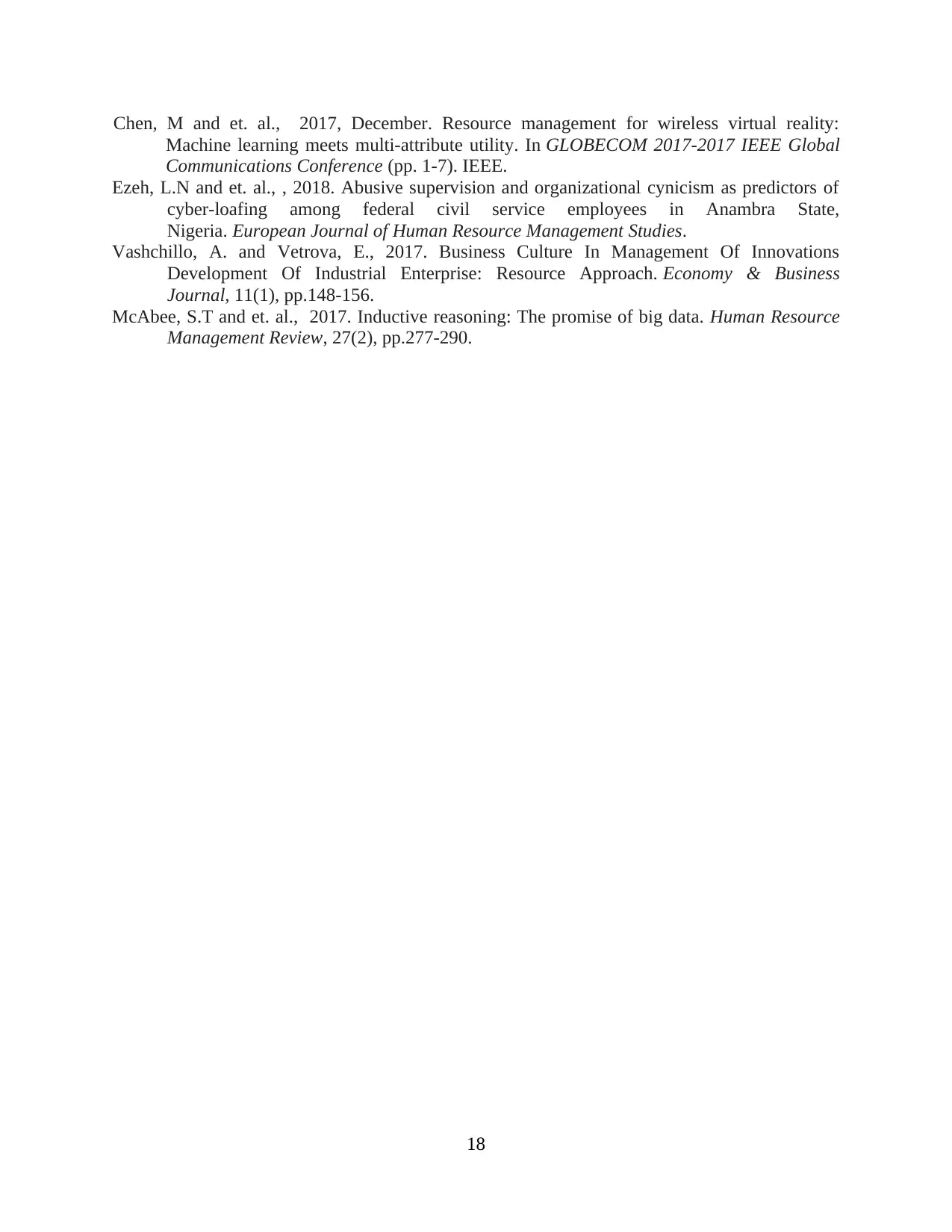
Chen, M and et. al., 2017, December. Resource management for wireless virtual reality:
Machine learning meets multi-attribute utility. In GLOBECOM 2017-2017 IEEE Global
Communications Conference (pp. 1-7). IEEE.
Ezeh, L.N and et. al., , 2018. Abusive supervision and organizational cynicism as predictors of
cyber-loafing among federal civil service employees in Anambra State,
Nigeria. European Journal of Human Resource Management Studies.
Vashchillo, A. and Vetrova, E., 2017. Business Culture In Management Of Innovations
Development Of Industrial Enterprise: Resource Approach. Economy & Business
Journal, 11(1), pp.148-156.
McAbee, S.T and et. al., 2017. Inductive reasoning: The promise of big data. Human Resource
Management Review, 27(2), pp.277-290.
18
Machine learning meets multi-attribute utility. In GLOBECOM 2017-2017 IEEE Global
Communications Conference (pp. 1-7). IEEE.
Ezeh, L.N and et. al., , 2018. Abusive supervision and organizational cynicism as predictors of
cyber-loafing among federal civil service employees in Anambra State,
Nigeria. European Journal of Human Resource Management Studies.
Vashchillo, A. and Vetrova, E., 2017. Business Culture In Management Of Innovations
Development Of Industrial Enterprise: Resource Approach. Economy & Business
Journal, 11(1), pp.148-156.
McAbee, S.T and et. al., 2017. Inductive reasoning: The promise of big data. Human Resource
Management Review, 27(2), pp.277-290.
18
You're viewing a preview
Unlock full access by subscribing today!
1 out of 18
Related Documents
Your All-in-One AI-Powered Toolkit for Academic Success.
+13062052269
info@desklib.com
Available 24*7 on WhatsApp / Email
![[object Object]](/_next/static/media/star-bottom.7253800d.svg)
Unlock your academic potential
© 2024 | Zucol Services PVT LTD | All rights reserved.





